
- April 24, 2024 | 30 Times Clearer – Scientists Develop Improved Mid-Infrared Microscope
- April 24, 2024 | Shedding Pounds, Dodging Cancer: The Life-Saving Promise of Bariatric Surgery
- April 24, 2024 | Quantum Computing Meets Genomics: The Dawn of Hyper-Fast DNA Analysis
- April 24, 2024 | Scientists Turn to Venus in the Search for Alien Life
- April 24, 2024 | NASA Astronauts Enter Quarantine As Boeing Starliner Test Flight Approaches

Hubble Finds Phantom Imprint in Space Revealing Black Hole Roaming Our Milky Way Galaxy
By Space Telescope Science Institute June 14, 2022
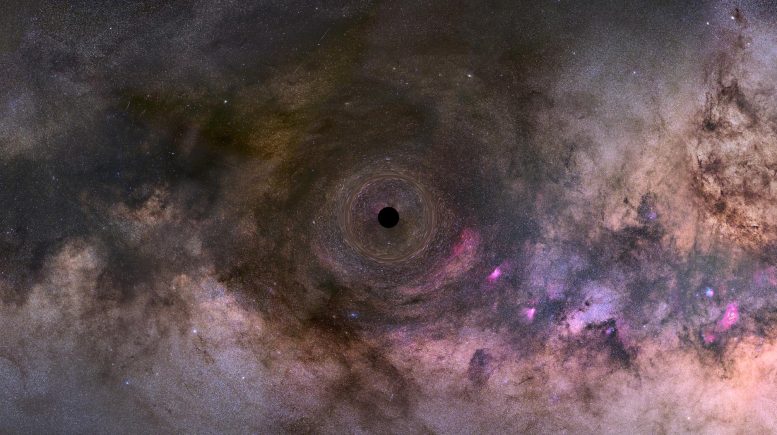
This is an illustration of a close-up look at a black hole drifting through our Milky Way galaxy. The black hole is the crushed remnant of a massive star that exploded as a supernova. The surviving core is several times the mass of our Sun. The black hole traps light due to its intense gravitational field. The black hole distorts the space around it, which warps images of background stars lined up almost directly behind it. This gravitational “lensing” effect offers the only telltale evidence for the existence of lone black holes wandering our galaxy, which may be a population of 100 million. The Hubble Space Telescope goes hunting for these black holes by looking for distortion in starlight as the black holes drift in front of background stars. Credit: FECYT, IAC
Hubble Determines Mass of Black Hole Isolated Black Hole
Supermassive black holes, such as Sagittarius A* — the black hole at the center of the Milky Way galaxy — lie at the center of virtually all galaxies. However, a small stellar mass black hole, which is sometimes left behind when massive stars explode in a supernova , can be on their own, isolated in space.
It is estimated that approximately one in a thousand stars is massive enough to give birth to a black hole. Since the galaxy.
By their very nature, black holes can be very hard to detect, especially if they are isolated. A key feature of black holes is that their gravitational pull is so powerful that even light can’t escape. This means we generally detect them by their gravitational influence on other objects or by radiation created by the surrounding matter they are feeding on. Without any nearby objects or accreting matter, there could be hundreds of millions of black holes throughout our galaxy that are essentially invisible to astronomers on Earth.
Our Milky Way galaxy is haunted. The vast gulf of space between the stars is plied by the dead, burned-out, and crushed remnants of once glorious stars. These black holes cannot be directly seen because their intense gravity swallows light. Like legendary wandering ghosts, their presence can only be deduced by seeing how they affect the environment around them.
Imagine crushing the mass of a fleet of battleships into something no bigger than a baseball. That only begins to describe the infinite density locked away into a black hole left over from a stellar explosion. The black hole is typically several times the mass of our Sun. The intense gravity from something so dense warps the fabric of space around it, like a bowling ball rolling across the skin of a trampoline. Starlight passing near this gravitational pothole in space is deflected. And this is how the phantom black holes are found.
Astronomers estimate that there should be 100 million black holes roaming among the 100 billion stars in our galaxy. But since black holes emit no light of their own, they are extremely difficult to detect. Now, astronomers have at last come up with clear evidence for finding one in a needle-in-a-haystack search among a blizzard of stars seen toward the galactic center. The light from a star far behind the black hole was momentarily brightened and deflected by the black hole passing in front of it. This was a long and painstaking measurement that the Hubble Space Telescope ’s exquisite resolution is well-suited for. The black hole’s powerful gravitation left a unique fingerprint on the deflection of starlight, eliminating other potential gravitational lensing candidates.
No need for us to worry because the black hole is 5,000 light-years away. But, statistically, this detection means that the nearest wandering black hole to Earth could be no more than 80 light-years away.
Hubble Space Telescope Determines Mass of Isolated Black Hole Roaming Our Milky Way Galaxy
Astronomers estimate that 100 million black holes roam among the stars in our Milky Way galaxy, but they have never conclusively identified an isolated black hole. Following six years of meticulous observations, NASA ’s Hubble Space Telescope has, for the first time ever, provided direct evidence for a lone black hole drifting through interstellar space by a precise mass measurement of the phantom object. Until now, all black hole masses have been inferred statistically, or through interactions in binary systems or in the cores of galaxies. Stellar-mass black holes are usually found with companion stars, making this one unusual.
The newly detected wandering black hole lies about 5,000 light-years away, in the Carina-Sagittarius spiral arm of our galaxy. However, its discovery allows astronomers to estimate that the nearest isolated stellar-mass black hole to Earth might be as close as 80 light-years away. The nearest star to our solar system, Proxima Centauri, is a little over 4 light-years away.
Black holes roaming our galaxy are born from rare, monstrous stars (less than one-thousandth of the galaxy’s stellar population) that are at least 20 times more massive than our Sun. These stars explode as supernovae, and the remnant core is crushed by gravity into a black hole. Because the self-detonation is not perfectly symmetrical, the black hole may get a kick, and go careening through our galaxy like a blasted cannonball.
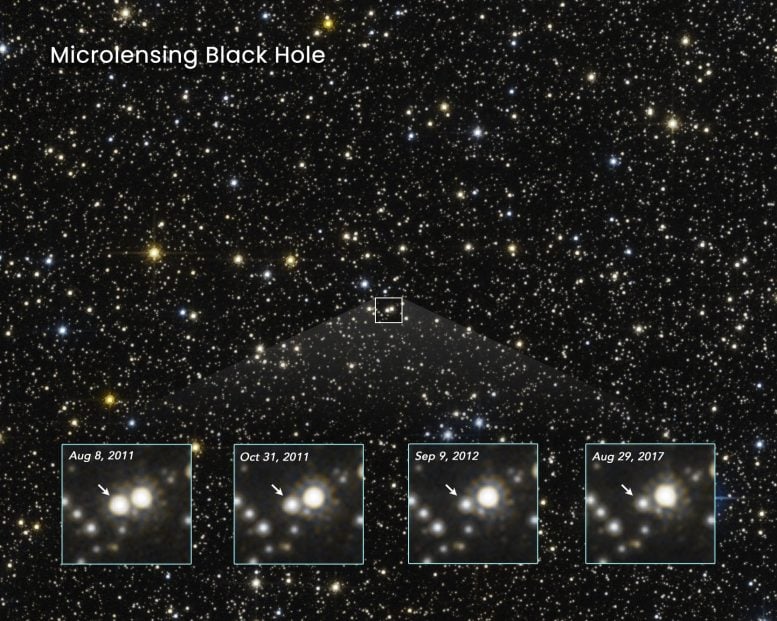
The star-filled sky in this Hubble Space Telescope photo is located in the direction of the Galactic center. The brightness of stars are monitored to see if any change in apparent brightness is made by a foreground object drifting in front of them. The warping of space by the interloper would momentarily brighten the appearance of a background star, due to an effect called gravitational lensing. One such event is shown along the four close-up frames at the bottom. The arrow points to a star that momentarily brightened, as first captured by Hubble beginning in August, 2011. This was caused by a foreground black hole drifting in front of the star, along our line-of-sight. The star brightened and then subsequently faded back to its normal brightness as the black hole passed by. Because a black hole doesn’t emit or reflect light, it cannot be directly observed. But its unique thumbprint on the fabric of space can be measured through these so-called microlensing events. Though an estimated 100 million isolated black holes roam our galaxy, finding the telltale signature of one is a needle-in-haystack search for Hubble astronomers. Credit: Science: NASA, ESA, Kailash Sahu (STScI), Image Processing: Joseph DePasquale (STScI)
Telescopes can’t photograph a wayward black hole because it doesn’t emit any light. However, a black hole warps space, which then deflects and amplifies starlight from anything that momentarily lines up exactly behind it.
Ground-based telescopes, which monitor the brightness of millions of stars in the rich star fields toward the central bulge of our Milky Way, look for a tell-tale sudden brightening of one of them when a massive object passes between us and the star. Then Hubble follows up on the most interesting such events.
Two teams used Hubble data in their investigations — one [1] led by Kailash Sahu of the Space Telescope Science Institute in Baltimore, Maryland; and the other [2] by Casey Lam of the University of California, Berkeley . The teams’ results differ slightly, but both suggest the presence of a compact object.
The warping of space due to the gravity of a foreground object passing in front of a star located far behind it will momentarily bend and amplify the light of the background star as it passes in front of it. Astronomers use the phenomenon, called gravitational microlensing, to study stars and exoplanets in the approximately 30,000 events seen so far inside our galaxy.
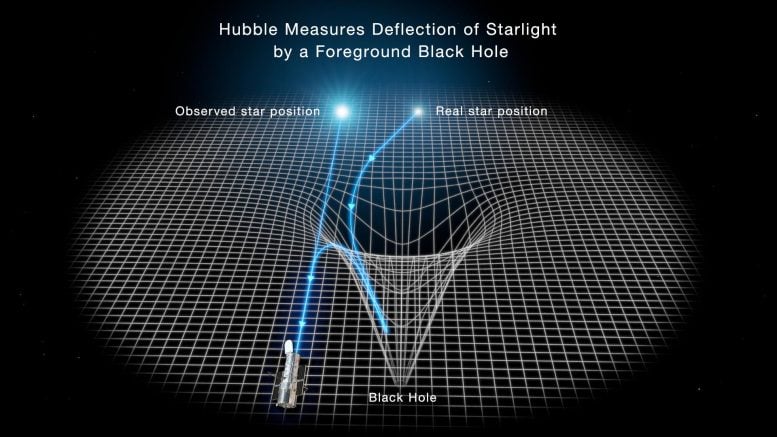
This illustration reveals how the gravity of a black hole warps space and bends the light of a distant star behind it. A black hole is the crushed remnant of a massive star that exploded as a supernova. The black hole traps light due to its intense gravitational field, hence it cannot be seen directly. The black hole distorts the space around it, which warps images of stars lined up almost directly behind it. This offers telltale evidence for the existence of lone black holes wandering our galaxy. The light from a background star is deflected and brightened by the black hole’s intense gravitational field. The Hubble Space Telescope goes hunting for these black holes by looking for distortion in starlight as the black hole drifts in front of background stars. Credit: NASA, ESA, STScI, Joseph Olmsted
The signature of a foreground black hole stands out as unique among other microlensing events. The very intense gravity of the black hole will stretch out the duration of the lensing event for over 200 days. Also, if the intervening object was instead a foreground star, it would cause a transient color change in the starlight as measured because the light from the foreground and background stars would momentarily be blended together. But no color change was seen in the black hole event.
Next, Hubble was used to measure the amount of deflection of the background star’s image by the black hole. Hubble is capable of the extraordinary precision needed for such measurements. The star’s image was offset from where it normally would be by about a milliarcsecond. That’s equivalent to measuring the diameter of a 25-cent coin in Los Angeles as seen from New York City.
This astrometric microlensing technique provided information on the mass, distance, and velocity of the black hole. The amount of deflection by the black hole’s intense warping of space allowed Sahu’s team to estimate that it weighs seven solar masses.
Lam’s team reports a slightly lower mass range, meaning that the object may be either a neutron star or a black hole. They estimate that the mass of the invisible compact object is between 1.6 and 4.4 times that of the Sun. At the high end of this range the object would be a black hole; at the low end, it would be a neutron star.
“As much as we would like to say it is definitely a black hole, we must report all allowed solutions. This includes both lower-mass black holes and possibly even a neutron star,” said Jessica Lu of the Berkeley team.
“Whatever it is, the object is the first dark stellar remnant discovered wandering through the galaxy unaccompanied by another star,” Lam added.
This was a particularly difficult measurement because there is a bright, unrelated star that is extremely close in angular separation to the source star. “So it’s like trying to measure the tiny motion of a firefly next to a bright light bulb,” said Sahu. “We had to meticulously subtract the light from the nearby bright star to precisely measure the deflection of the faint source.”
Sahu’s team estimates the isolated black hole is traveling across the galaxy at 100,000 miles per hour, or 160,000 kilometers (fast enough to travel from Earth to the Moon in less than three hours). That’s faster than most of the other neighboring stars in that region of our galaxy.
“Astrometric microlensing is conceptually simple but observationally very tough,” said Sahu. “Microlensing is the only technique available for identifying isolated black holes.” When the black hole passed in front of a background star located 19,000 light-years away in the galactic bulge, the starlight coming toward Earth was amplified for a duration of 270 days as the black hole passed by. However, it took several years of Hubble observations to follow how the background star’s position appeared to be deflected by the bending of light by the foreground black hole.
The existence of stellar-mass black holes has been known since the early 1970s, but all of their mass measurements—until now—have been in binary star systems. Gas from the companion star falls into the black hole and is heated to such high temperatures that it emits X-rays. About two dozen black holes have had their masses measured in X-ray binaries through their gravitational effect on their companions. Mass estimates range from 5 to 20 solar masses. Black holes detected in other galaxies by gravitational waves from mergers between black holes and companion objects have been as high as 90 solar masses.
“Detections of isolated black holes will provide new insights into the population of these objects in our Milky Way,” said Sahu. But it is a needle-in-a-haystack search. The prediction is that only one in a few hundred microlensing events are caused by isolated black holes.
NASA’s upcoming Nancy Grace Roman Space Telescope will discover several thousand microlensing events out of which many are expected to be black holes, and the deflections will be measured with very high accuracy .
In a 1916 paper on general relativity, Albert Einstein predicted that his theory could be tested by observing the Sun’s gravity offsetting the apparent position of a background star. This was tested by a collaboration led by astronomers Arthur Eddington and Frank Dyson during a solar eclipse on May 29, 1919. Eddington and his colleagues measured a background star being offset by 2 arcseconds, validating Einstein’s theories. These scientists could hardly have imagined that over a century later this same technique would be used – with unimaginable precision of a thousandfold better — to look for black holes across the galaxy.
For more on this topic, see Astronomers May Have Detected a “Dark” Free-Floating Black Hole .
References:
“An Isolated Stellar-Mass Black Hole Detected Through Astrometric Microlensing” by Kailash C. Sahu, Jay Anderson, Stefano Casertano, Howard E. Bond, Andrzej Udalski, Martin Dominik, Annalisa Calamida, Andrea Bellini, Thomas M. Brown, Marina Rejkuba, Varun Bajaj, Noe Kains, Henry C. Ferguson, Chris L. Fryer, Philip Yock, Przemek Mroz, Szymon Kozlowski, Pawel Pietrukowicz, Radek Poleski, Jan Skowron, Igor Soszynski, Michael K. Szymanski, Krzysztof Ulaczyk, Lukasz Wyrzykowski, Richard Barry, David P. Bennett, Ian A. Bond, Yuki Hirao, Stela Ishitani Silva, Iona Kondo, Naoki Koshimoto, Clement Ranc, Nicholas J. Rattenbury, Takahiro Sumi, Daisuke Suzuki, Paul J. Tristram, Aikaterini Vandorou, Jean-Philippe Beaulieu, Jean-Baptiste Marquette, Andrew Cole, Pascal Fouque, Kym Hill, Stefan Dieters, Christian Coutures, Dijana Dominis-Prester, Clara Bennett, Etienne Bachelet, John Menzies, Michael Alb-row, Karen Pollard, Andrew Gould, Jennifer Yee, William Allen, Leonardo Andrade de Almeida, Grant Christie, John Drummond, Avishay Gal-Yam, Evgeny Gorbikov, Francisco Jablonski, Chung-Uk Lee, Dan Maoz, Ilan Manulis, Jennie McCormick, Tim Natusch, Richard W. Pogge, Yossi Shvartzvald, Uffe G. Jorgensen, Khalid A. Alsubai, Michael I. Andersen, Valerio Bozza, Sebastiano Calchi Novati, Martin Burgdorf, Tobias C. Hinse, Markus Hundertmark, Tim-Oliver Husser, Eamonn Kerins, Penelope Longa-Pena, Luigi Mancini, Matthew Penny, Sohrab Rahvar, Davide Ricci, Sedighe Sajadian, Jesper Skottfelt, Colin Snodgrass, John Southworth, Jeremy Tregloan-Reed, Joachim Wambsganss, Olivier Wertz, Yiannis Tsapras, Rachel A. Street, Daniel M. Bramich, Keith Horne and Iain A. Steele, 25 May 2022, Astrophysics > Solar and Stellar Astrophysics . arXiv:2201.13296
“An isolated mass gap black hole or neutron star detected with astrometric microlensing” by Casey Y. Lam, Jessica R. Lu, Andrzej Udalski, Ian Bond, David P. Bennett, Jan Skowron, Przemek Mroz, Radek Poleski, Takahiro Sumi, Michal K. Szymanski, Szymon Kozlowski, Pawel Pietrukowicz, Igor Soszynski, Krzysztof Ulaczyk, Lukasz Wyrzykowski, Shota Miyazaki, Daisuke Suzuki, Naoki Koshimoto, Nicholas J. Rattenbury, Matthew W. Hosek Jr., Fumio Abe, Richard Barry, Aparna Bhattacharya, Akihiko Fukui, Hirosane Fujii, Yuki Hirao, Yoshitaka Itow, Rintaro Kirikawa, Iona Kondo, Yutaka Matsubara, Sho Matsumoto, Yasushi Muraki, Greg Olmschenk, Clement Ranc, Arisa Okamura, Yuki Satoh, Stela Ishitani Silva, Taiga Toda, Paul J. Tristram, Aikaterini Vandorou, Hibiki Yama, Natasha S. Abrams, Shrihan Agarwal, Sam Rose and Sean K. Terry, Accepted, The Astrophysical Journal Letters . arXiv:2202.01903
The Hubble Space Telescope is a project of international cooperation between NASA and ESA ( European Space Agency ). NASA’s Goddard Space Flight Center in Greenbelt, Maryland, manages the telescope. The Space Telescope Science Institute (STScI) in Baltimore, Maryland, conducts Hubble science operations. STScI is operated for NASA by the Association of Universities for Research in Astronomy in Washington, D.C.
More on SciTechDaily
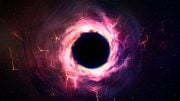
Stellar “Ghost” Discovered: Astronomers May Have Detected a “Dark” Free-Floating Black Hole

Quick ‘Bang’ Signals the Most Massive Gravitational-Wave Source Ever Detected
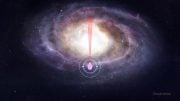
Roman Space Telescope Will Detect Exoplanets Using Warped Space-Time

NASA’s Gravity Assist: Black Hole Mysteries
Stunning reveal: first image of the black hole at the center of our milky way galaxy.

Missing Seeds: Mysterious Enigma of Supermassive Black Holes
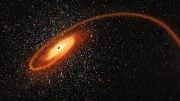
Hubble Finds “Missing Link” Black Hole Tearing Apart a Star That Passed Too Close [Video]
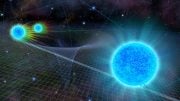
10 Crucial Things That Result From Einstein’s Theories of Relativity
2 comments on "hubble finds phantom imprint in space revealing black hole roaming our milky way galaxy".
Being $US31T in debt on the verge of collapse, children starving to death on the street as idiot politicians point weapons at us to create mass extinction of our species, wouldn’t it be more logical to point our limited resources to solve self-induced armagheddon at the only home we’re ever going to have?
Too bad the authors didn’t give us an odds estimate of us being some black Hole’s dinner, in relation to being struck by lightning.
Leave a comment Cancel reply
Email address is optional. If provided, your email will not be published or shared.
Save my name, email, and website in this browser for the next time I comment.
There’s a Black Hole in Our Galaxy With 7 Times More Mass Than the Sun, Astronomers Say
The wandering, lone black hole sits an estimated 5,000 light years away from us.
- Hubble spent six years observing the black hole.
- The newly-detected black hole is in the Carina-Sagittarius spiral arm of the Milky Way , just 5,000 light years from Earth.
Conclusive, measurable observation of a lone black hole occurred for the first time ever, thanks to the Hubble Space Telescope. The $1.2 billion telescope, first launched in 1990 , spent six years monitoring a black hole drifting through interstellar space, measuring the object and giving us the first-ever direct evidence of a region in space-time where gravity is so strong that nothing can escape from it.
The newly-famous stellar-mass black hole is a rare one in that it isn’t accompanied by stars, NASA explains in a June 10 press release . It’s wandering about 5,000 light years away in the Carina-Sagittarius spiral arm of our Milky Way galaxy . What’s fascinating here is that Hubble’s measurements gave astronomers direct access to evidence of the black hole—instead of relying on inferred statistics or data from binary-system interactions.
Black holes free-floating in the Milky Way are relatively rare. For a black hole to form in the first place, a monstrous star at least 20 times larger than Earth’s sun—NASA says less than one-thousandth of the galaxy’s stellar population fits the criteria—must explode (think: supernova ). From there, the “remnant core is crushed by gravity into a black hole,” according to the NASA release. Following the detonation, the black hole may start traveling the galaxy, a move the space agency likens to a “blasted cannonball.”
Photographing a black hole isn’t possible because there’s no light. What we do see, though, is the warping of space around it, deflecting and amplifying starlight from anything that momentarily lines up exactly behind the black hole. (Though the Event Horizon Telescope Collaboration did release an image of a black hole last month , what we’re really viewing is the glowing gas orbiting around it via a bright ring-like form). When ground-based telescopes catch a sudden brightening of a star when a massive object passes between us and the star, astronomers can follow up on these events to study the black hole.
So, for six years, Hubble tracked this particular black hole , and two teams used the data to measure it. One group hails from the Space Telescope Science Institute in Baltimore, and the other from the University of California, Berkeley. The two teams published their results to the arXiv pre-print server (meaning the research has not yet been peer-reviewed) last month.
As NASA explains, astronomers use gravitational micro-lensing—when the light from a star momentarily bends and amplifies as it passes behind a black hole—to determine how long the lensing event lasts, sometimes for more than 250 days. How the colors of the stars appear can also give scientists information on the location of the black hole.
🔭 Get to Know Hubble
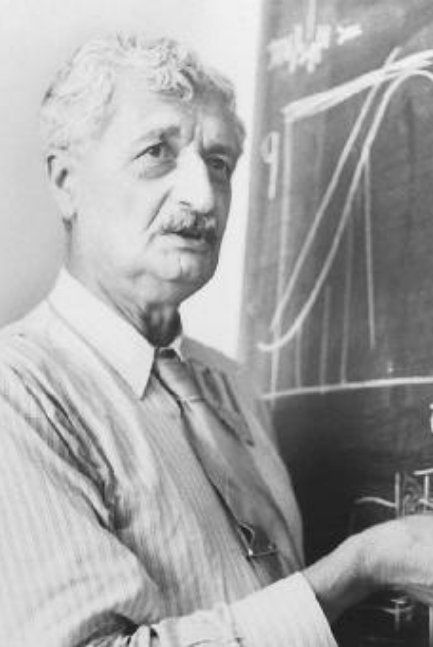
With this information, Hubble measured the amount of deflection of the background star’s image by the black hole, using such precise measurements that NASA says it’s equivalent to measuring the diameter of a quarter in Los Angeles as seen from New York City.
All this information helped the two research teams in determining the mass, distance, and velocity of the newly-found black hole. The Baltimore scientists predict this black hole is up to 4.4 times the size of our sun, although the Berkeley team believes it could be more on the order of 1.6 times the size of the sun—technically making it a neutron star, rather than a black hole. (A neutron star is the collapsing core of a star on the brink of death.)
Astronomers use “solar mass” as the basic unit of measurement for a black hole’s mass. One solar mass is equal to the mass of the sun, about the mass of 333,000 Earths (or 1.989 x 10^30 kilograms, to be specific). Estimates of Milky Way black holes have ranged anywhere from five to 20 solar masses, but those were all indirect measurements. The freshly-discovered black hole could be as large as seven solar masses.
“As much as we would like to say it is definitively a black hole, we must report all allowed solutions,” Jessica Lu of the Berkeley team says in the NASA release. “This includes both lower mass black holes and possibly even a neutron star.” Still, it’s the first dark stellar remnant discovered wandering through the galaxy unaccompanied by another star, Casey Lam, also of Berkeley, says in the release.
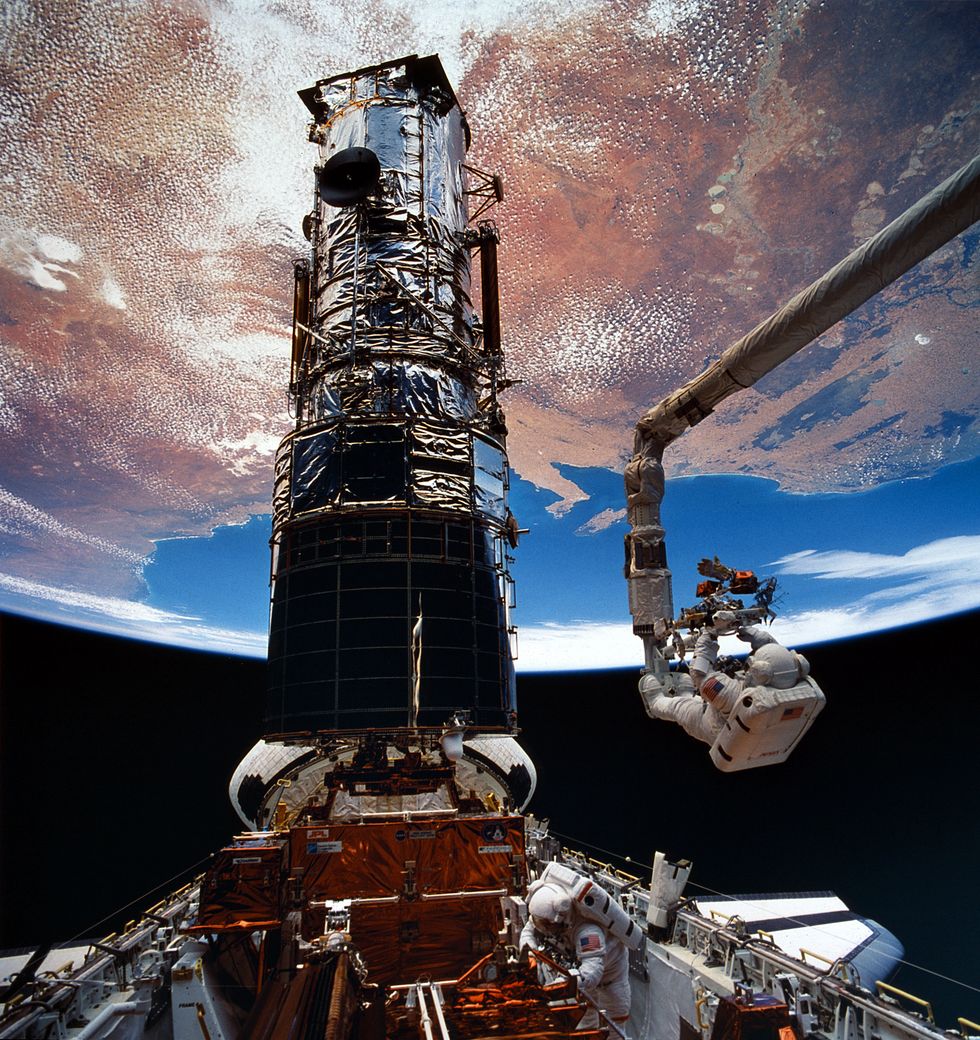
Kailash Sahu of the Baltimore team says a nearby unrelated star’s brightness made measurements difficult. “It’s like trying to measure the tiny motion of a firefly next to a bright light bulb,” Sahu says in the news release. “We had to meticulously subtract the light from the nearby bright star to precisely measure the deflection of the faint source.”
With that, the team believes the isolated black hole is traveling at 100,000 miles per hour—that’s Earth to the moon in three hours—and faster than most neighboring stars.
With an estimated 100 million black holes among Milky Way stars, the new data leads NASA experts to believe there could be an isolated stellar-mass black hole as close as 80 light years away. NASA believes the upcoming Nancy Grace Roman Space Telescope can use intense accuracy to sift through thousands of micro-lensing events to find additional black holes.
Tim Newcomb is a journalist based in the Pacific Northwest. He covers stadiums, sneakers, gear, infrastructure, and more for a variety of publications, including Popular Mechanics. His favorite interviews have included sit-downs with Roger Federer in Switzerland, Kobe Bryant in Los Angeles, and Tinker Hatfield in Portland.

.css-cuqpxl:before{padding-right:0.3125rem;content:'//';display:inline;} Pop Mech Exclusives .css-xtujxj:before{padding-left:0.3125rem;content:'//';display:inline;}

7 Solid Reasons to Actually Believe in Aliens

The Fortress For the World’s Ancient Manuscripts

A Fifth Ocean May Be Forming, Scientists Say

What It’s Really Like to Be a CIA ‘Shadow Warrior’

How Dead People Are Turned Into Diamonds

This Year's Burning Man Had Lots of Sea Monkeys

Was Amelia Earhart Eaten by Crabs?

How to Remove Wallpaper

New Photo May Be a Clue in Earhart Mystery

Why Air Turbulence Is Getting Worse

New Medicine May Help New Teeth Grow
Astronomers Discover a ‘Sleeping Giant’ Black Hole in Our Galaxy—the Second-Closest Known to Earth
Called Gaia BH3, the dormant black hole is 33 times more massive than the sun, making it the largest recorded stellar black hole in the Milky Way
/https://tf-cmsv2-smithsonianmag-media.s3.amazonaws.com/accounts/headshot/ChristianThorsberg_Headshot.png)
Christian Thorsberg
Daily Correspondent
:focal(580x331:581x332)/https://tf-cmsv2-smithsonianmag-media.s3.amazonaws.com/filer_public/19/32/19321ec4-4ae9-4749-ad51-7ec75adbf27a/gaia1.webp)
Less than 2,000 light-years away from Earth, scientists have discovered a “sleeping giant”—the Milky Way’s largest stellar black hole, with a mass 33 times greater than that of our sun. Though the black hole, named Gaia BH3, is the second-closest known to our home planet, it is “dormant” and had therefore gone undetected.
“It’s a complete surprise,” Pasquale Panuzzo , the study’s lead author and an astronomer at the Observatoire de Paris, tells the Guardian ’s Ian Sample.
Located in the constellation Aquila the eagle, Gaia BH3 was uncovered by chance in a mass of data and observations collected by European Space Agency (ESA) astronomers. As the team reviewed findings from the agency’s Gaia Mission , which is building a 3D map of our galaxy, something unusual caught their attention: a wobbling star some 1,926 light-years away. The object’s curious motion indicated that a large black hole nearby had locked it into an orbit.
To verify their finding, the team of astronomers and ground operators used the European Southern Observatory’s Very Large Telescope, located in Chile, to confirm Gaia BH3’s mass. In findings published in the journal Astronomy & Astrophysics , they shared that the wobbling star orbits the black hole every 11.6 years.
“No one was expecting to find a high-mass black hole lurking nearby, undetected so far,” Panuzzo says in a statement . “This is the kind of discovery you make once in your research life.”

Gaia BH3 is a type of black hole caused by the collapse of a star, known as a stellar black hole—and it’s the largest of this type discovered in our galaxy. As a “dormant” black hole, it isn’t actively siphoning energy and materials from a companion star, making it inconspicuous in surveys of the sky.
The average size of stellar black holes in the Milky Way is about ten times the mass of the sun, with the previous record-holder, called Cygnus X-1, being 21 times the mass of the sun. Still, on the grand scale of all black holes, the 33-solar-mass Gaia BH3 is relatively small. For instance, Sagittarius A* , the supermassive black hole in the center of the Milky Way, has a mass four million times larger than that of the sun.
Gaia BH3 is the second-closest black hole to Earth, behind only Gaia BH1, which is 1,500 light-years away and ten times the mass of the sun.
“The relatively small distance to Gaia BH3 can be illustrated by noting that the light observed by Gaia was emitted by the star at the time when classical Rome was governed by Emperor Nero,” Tomaž Zwitter , an astronomer at the University of Ljubljana in Slovenia and a member of the Gaia Collaboration, says in an ESA statement .
/https://tf-cmsv2-smithsonianmag-media.s3.amazonaws.com/filer_public/bd/9a/bd9ad45c-ddd3-4a5d-b5a5-a3f40d21de19/gaia2.webp)
The discovery is significant, as it provides astronomers with clues to better understand how the deaths of ancient stars gave rise to stellar black holes.
Astronomers had previously posited that more massive stellar black holes are formed from stars that do not contain many heavy metals. Instead composed largely of hydrogen and helium, these metal-poor stars are thought to lose less mass over time, resulting in more material left over at the end of their lives with which to form more massive black holes.
But until finding Gaia BH3 and its companion star—which was indeed metal-poor, suggesting the one that formed the black hole was also low in metal—scientists hadn’t had an example to draw from. This finding adds substance to the idea.
“What strikes me is that the chemical composition of the companion is similar to what we find in old metal-poor stars in the galaxy,” Elisabetta Caffau , an astronomer with CNRS, Observatoire de Paris and a member of the Gaia collaboration, says in a statement .
Gaia BH3’s companion star likely formed within two billion years of the Big Bang, which scientists estimate occurred 13.8 billion years ago. Because the star orbits in the opposite direction as the majority of Milky Way stars, it may have originally been part of another galaxy that then merged with ours more than eight billion years ago. It doesn’t seem affected from the stellar explosion that would have created Gaia BH3, so ESA astronomers suggest the black hole captured this star after it was born.
As the Gaia project continues to develop its map of the Milky Way , the next installment of its data is slated to be published no sooner than 2025. But the team chose to release the news of Gaia BH3 early, in hopes their initial observations can serve as bread crumbs for other astronomers’ future study.
“It’s impressive to see the transformational impact Gaia is having on astronomy and astrophysics,” Carole Mundell , the European Space Agency’s director of science, says in the statement. “Its discoveries are reaching far beyond the original purpose of the mission.”
Get the latest stories in your inbox every weekday.
/https://tf-cmsv2-smithsonianmag-media.s3.amazonaws.com/accounts/headshot/ChristianThorsberg_Headshot.png)
Christian Thorsberg | READ MORE
Christian Thorsberg is an environmental writer and photographer from Chicago. His work, which often centers on freshwater issues, climate change and subsistence, has appeared in Circle of Blue , Sierra magazine, Discover magazine and Alaska Sporting Journal .
Record breaker! Milky Way's most monstrous stellar-mass black hole is sleeping giant lurking close to Earth (Video)
"This is the kind of discovery you make once in your research life."

The Milky Way has a big newfound black hole, and it lurks close to Earth! This sleeping giant was discovered with the European space telescope Gaia, which tracks the motion of billions of stars in our galaxy.
Stellar-mass black holes are created when a large star runs out of fuel and collapses. The new discovery is a landmark, representing the first time that a big black hole with such an origin has been found close to Earth . The stellar-mass black hole, designated Gaia-BH3, is 33 times more massive than our sun . The previous most massive black hole of this class found in the Milky Way was a black hole in an X-ray binary in the Cygnus constellation ( Cyg X-1 ), whose mass is estimated to be around 20 times that of the sun. The average stellar-mass black hole in the Milky Way is about 10 times heftier than the sun.
Gaia-BH3 is located just 2,000 light years from Earth, making it the second-closest black hole to our planet ever discovered. The closest black hole to Earth is Gaia-BH1 (also discovered by Gaia ), which is 1,560 light-years away. Gaia-BH1 has a mass around 9.6 times that of the sun, making it considerably smaller than this newly discovered black hole.
Related: New view of the supermassive black hole at the heart of the Milky Way hints at an exciting hidden feature (image)
"Finding Gaia BH3 is like the moment in the film 'The Matrix' where Neo starts to 'see' the matrix," George Seabroke, a scientist at Mullard Space Science Laboratory at University College London and a member of Gaia's Black Hole Task Force, said in a statement sent to Space.com. "In our case, 'the matrix' is our galaxy’s population of dormant stellar black holes, which were hidden from us before Gaia detected them." Seabroke added that Gaia BH3 is an important clue to this population, because it is the most massive stellar black hole found in our galaxy.
Of course, Gaia-BH3 is a small fry compared to the supermassive black hole that dominates the heart of the Milky Way , Sagittarius A* (Sgr A*), which has a mass 4.2 million times that of the sun. Supermassive black holes like Sgr A* aren't created by the deaths of massive stars but rather by mergers of progressively larger and larger black holes.
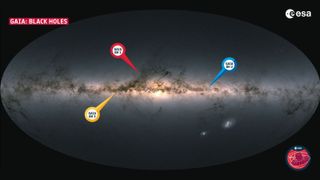
Sleeping giant black hole caused stellar companion to throw a wobbly
All black holes are marked by an outer boundary called an event horizon , at which point the black hole's escape velocity exceeds the speed of light . That means an event horizon is a one-way light-trapping surface beyond which no information can escape.
Get the Space.com Newsletter
Breaking space news, the latest updates on rocket launches, skywatching events and more!
As a result, black holes don't emit or reflect light, meaning they can only be "seen" when they are surrounded by material that they gradually feed on. Sometimes, this means a black hole in a binary system pulling material from a companion star, which forms a disk of gas and dust around it.
The tremendous gravitational influence of black holes generates intense tidal forces in this surrounding matter, causing it to glow brightly with material that is destroyed and consumed, also emitting X-rays. Additionally, the material the black hole doesn't feast on can be channeled to its poles and blasted out as near-light speed jets , which are accompanied by the emission of light.
All of these light emissions can allow astronomers to spot black holes. The question is, how can "dormant" black holes that aren't feeding on gas and dust around them be detected? For instance, what if a stellar-mass black hole has a companion star, but the two are too widely separated for the black hole to snatch stellar matter from its binary partner?
In cases like this, the black hole and its companion star orbit a point that represents the system's center of mass. This is also the case when a star is orbited by a light companion, such as another star or even a planet.
Orbiting the center of mass results in a wobble in the motion of the star, which is visible to astronomers. Because Gaia is adept at precisely measuring the motion of stars , it is the ideal instrument to see this wobble.
Gaia’s Black Hole Task Force set about looking for odd wobbles that couldn't be accounted for by the presence of another star or a planet and that indicated a heavier companion, possibly a black hole.

Homing in on an old giant star in the constellation Aquila, located 1,926 light-years from Earth, the team found a wobble in the star's path. That wobble suggests that the star is locked in orbital motion with a dormant black hole of exceptionally high mass. The two are separated by a distance that ranges from the distance between the sun and Neptune at their widest and our star and Jupiter at their closest.
"It's a real unicorn," lead researcher Pasquale Panuzzo of CNRS, Observatoire de Paris in France, said in a statement. "This is the kind of discovery you make once in your research life. So far, black holes this big have only ever been detected in distant galaxies by the LIGO-Virgo-KAGRA collaboration, thanks to observations of gravitational waves ."
Related: What are gravitational waves?

Thanks to the sensitivity of Gaia , the Black Hole Task Force was also able to put constraints on the mass of Gaia-BH3, finding it to possess 33 solar masses.
"Gaia-BH3 is the very first black hole for which we could measure the mass so accurately," said Tsevi Mazeh, a scientist and Gaia collaboration member at Tel Aviv University. "At 30 times that of our sun, the object’s mass is typical of the estimates we have for the masses of the very distant black holes observed by gravitational wave experiments. Gaia’s measurements provide the first undisputable proof that [stellar-mass] black holes this heavy do exist."
— How do some black holes get so big? The James Webb Space Telescope may have an answer
— Brightest quasar ever seen is powered by black hole that eats a 'sun a day'
— Black hole-like 'gravastars' could be stacked like Russian tea dolls
However, the Gaia-BH3 system is bound to be of great interest to scientists for more than just its proximity to Earth and the mass of its black hole.
The star in this system is a sub-giant star that is around five times as large as the sun with 15 times its brightness, though it is cooler and less dense than our star. The Gaia-BH3 companion star is mainly composed of hydrogen and helium, the universe's two lightest elements, lacking heavier elements, which astronomers (somewhat confusingly) call "metals." The fact that this star is "metal-poor" suggests that the star that collapsed and died to create Gaia-BH3 also lacked heavier elements. Metal-poor stars are expected to shed more mass than their more metal-rich counterparts during their lives, so scientists have questioned if they can maintain enough mass to birth black holes. Gaia-BH3 represents the first hint that metal-poor stars can indeed do so.
"Gaia’s next data release is expected to contain many more, which should help us to 'see' more of 'the matrix' and to understand how dormant stellar black holes form," Seabroke concluded.
The team's research was published today (April 16) in the journal Astronomy & Astrophysics .
Join our Space Forums to keep talking space on the latest missions, night sky and more! And if you have a news tip, correction or comment, let us know at: [email protected].

Robert Lea is a science journalist in the U.K. whose articles have been published in Physics World, New Scientist, Astronomy Magazine, All About Space, Newsweek and ZME Science. He also writes about science communication for Elsevier and the European Journal of Physics. Rob holds a bachelor of science degree in physics and astronomy from the U.K.’s Open University. Follow him on Twitter @sciencef1rst.
Scientists use AI to reconstruct energetic flare blasted from Milky Way's supermassive black hole
Monster black hole seen feeding on nearby matter just 1 billion years after Big Bang (photos)
US Space Force picks Rocket Lab for 2025 Victus Haze space domain awareness mission
- gmcdermo "just" 2000 light years away... I can hardly wait for people demanding that Space Force protect us from those nearby black holes... Reply
- billslugg How close? I'm on 12th near the transit hub, will it get near there? If so I'm taking the crosstown. No sense taking any extra risk. Reply
- View All 2 Comments
Most Popular
- 2 Wow! Private space-junk probe snaps historic photo of discarded rocket in orbit
- 3 Laser on NASA's Psyche asteroid probe beams data from 140 million miles away
- 4 Satellites spot clusters of 'spiders' sprawled across Mars' Inca City (photo)
- 5 5 sci-fi movies that weren't great but still deserve a sequel
Thank you for visiting nature.com. You are using a browser version with limited support for CSS. To obtain the best experience, we recommend you use a more up to date browser (or turn off compatibility mode in Internet Explorer). In the meantime, to ensure continued support, we are displaying the site without styles and JavaScript.
- View all journals
- Explore content
- About the journal
- Publish with us
- Sign up for alerts
- 12 May 2022
- Correction 20 May 2022
Black hole at the centre of our Galaxy imaged for the first time
- Davide Castelvecchi
You can also search for this author in PubMed Google Scholar
Radioastronomers have imaged the supermassive black hole at the centre of the Milky Way. It is only the second-ever direct image of a black hole, after the same team unveiled a historic picture of a more distant black hole in 2019.
Access options
Access Nature and 54 other Nature Portfolio journals
Get Nature+, our best-value online-access subscription
24,99 € / 30 days
cancel any time
Subscribe to this journal
Receive 51 print issues and online access
185,98 € per year
only 3,65 € per issue
Rent or buy this article
Prices vary by article type
Prices may be subject to local taxes which are calculated during checkout
Nature 605 , 403-404 (2022)
doi: https://doi.org/10.1038/d41586-022-01320-y
Additional reporting by Freda Kreier.
Updates & Corrections
Correction 20 May 2022 : An earlier version of this story incorrectly described Katie Bouman as a former EHT team member. She is a current member of the EHT team.
Akiyama, K. et al. Astrophys. J. Lett. 930 , L12 (2022).
Article Google Scholar
Download references
Reprints and permissions
Related Articles

The first-ever image of a black hole is now a movie
- Astronomy and astrophysics

China's Moon atlas is the most detailed ever made
News 25 APR 24

A magnetar giant flare in the nearby starburst galaxy M82
Article 24 APR 24

Galaxy found napping in the primordial Universe
News & Views 24 APR 24
Junior Group Leader
The Imagine Institute is a leading European research centre dedicated to genetic diseases, with the primary objective to better understand and trea...
Paris, Ile-de-France (FR)
Imagine Institute
Director of the Czech Advanced Technology and Research Institute of Palacký University Olomouc
The Rector of Palacký University Olomouc announces a Call for the Position of Director of the Czech Advanced Technology and Research Institute of P...
Czech Republic (CZ)
Palacký University Olomouc
Course lecturer for INFH 5000
The HKUST(GZ) Information Hub is recruiting course lecturer for INFH 5000: Information Science and Technology: Essentials and Trends.
Guangzhou, Guangdong, China
The Hong Kong University of Science and Technology (Guangzhou)
Suzhou Institute of Systems Medicine Seeking High-level Talents
Full Professor, Associate Professor, Assistant Professor
Suzhou, Jiangsu, China
Suzhou Institute of Systems Medicine (ISM)
Postdoctoral Fellowships: Early Diagnosis and Precision Oncology of Gastrointestinal Cancers
We currently have multiple postdoctoral fellowship positions within the multidisciplinary research team headed by Dr. Ajay Goel, professor and foun...
Monrovia, California
Beckman Research Institute, City of Hope, Goel Lab
Sign up for the Nature Briefing newsletter — what matters in science, free to your inbox daily.
Quick links
- Explore articles by subject
- Guide to authors
- Editorial policies
It’s a wonderful world — and universe — out there.
Come explore with us!
Science News Explores
A massive rogue roaming our galaxy may be a black hole.
Some think this unseen interstellar wanderer may be a hefty neutron star instead
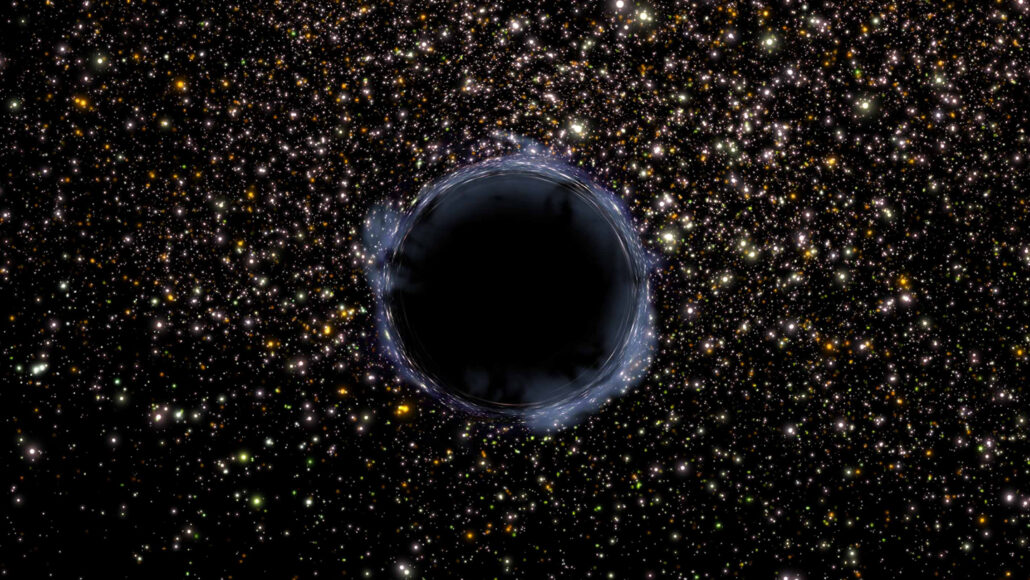
Here’s an artist’s illustration of a small black hole roaming our galaxy.
NASA and G. Bacon/STScI
Share this:
- Google Classroom
By Katherine Kornei
July 4, 2022 at 6:30 am
A solitary and massive celestial object is wandering our galaxy a few thousand light-years from Earth. It’s not too big, but its mass is greater than our sun’s. Astronomers suspect it might be the first loner black hole in the Milky Way found with a mass similar to our sun’s. Or it could prove to be one of the heaviest neutron stars known.
This wanderer first revealed itself in 2011. It wasn’t seen. Astronomers instead found it when its gravity briefly magnified the light from a more distant star. Back then, no one was sure what it might be. Now, two teams of astronomers have analyzed images from the Hubble Space Telescope. They’re still not entirely sure what the weighty object is, but they’ve narrowed down the list of candidates.
One group suspects this mysterious rogue is a black hole roughly seven times as massive as the sun. Make no mistake, its 94 authors say: “We report the first unambiguous detection and mass measurement of an isolated stellar-mass black hole .” They describe it in a paper due out soon in the Astrophysical Journal .
Not so fast, says another team of 45 scientists. They think it’s a bit lighter — a mere two to four times the weight of our nearest star . If true, that would make it an unusually lightweight black hole — or a curiously hefty neutron star. This group will share its findings in an upcoming issue of Astrophysical Journal Letters .
Both neutron stars and stellar-mass black holes can form when massive stars — ones with at least several times the heft of our sun — collapse under their own gravity. This happens at the end of those stars’ lives. Astronomers now believe that about a billion neutron stars and roughly 100 million stellar-mass black holes lurk in our galaxy .
Neither of these types of objects is easy to spot. Neutron stars are tiny — only about the size of a city. They also produce little light. Black holes, regardless of their size, emit no light at all. To detect these objects, then, scientists typically observe how they affect what’s around them.
“The only way that we can find them is if they influence something else,” explains Kailash Sahu. He’s an astronomer at the Space Telescope Science Institute in Baltimore, Md.
The massive mystery
To date, scientists have detected nearly two dozen stellar-mass black holes. (These are puny compared to their supermassive cousins that sit in the center of most galaxies, including our own .) Researchers found those relatively tiny black holes by observing changes in some of their neighbors. Sometimes, a black hole and a normal star will get caught in a spiral. Think of it as a dance.
But it’s a dangerous dance, as the black hole rips away matter from that companion star. As the star’s material falls onto the black hole, it emits X-rays. Telescopes orbiting Earth can detect that radiation. But scientists will find it hard to know how big a black hole was before it started dining on the star. And since birthweight is a key characteristic of a black hole, looking at black holes that are eating stars can confuse the picture. That’s why, Sahu says, “If we want to understand the properties of black holes, it’s best to find isolated ones” — like the new loner.
For more than a decade, researchers have been scanning the heavens for such isolated black holes. Hoping to spot these rogues, the scientists have looked for distorted starlight.
Educators and Parents, Sign Up for The Cheat Sheet
Weekly updates to help you use Science News Explores in the learning environment
Thank you for signing up!
There was a problem signing you up.
Einstein’s theory of general relativity states that the gravity associated with any massive object — even an unseen one — will bend the space in its vicinity . That bending magnifies and distorts the light of background stars. Astronomers refer to this as gravitational lensing. By measuring changes in the brightness and apparent position of stars, scientists can calculate the mass of a traveling object that’s acting like a lens. That technique has already turned up several exoplanets .
In 2011, researchers announced that they had spotted a star that suddenly got more than 200 times brighter. Those observations, made using telescopes in Chile and New Zealand, couldn’t nail down whether the star’s apparent position was also changing. And that information would be key to pinning down the mass of the object that was acting like a lens. If it’s a heavyweight, its gravity would distort space so much that the star would appear to move. Even a “big” shift in the star’s position, however, would have been very small and hard to detect. And it’s hard to see fine details in images captured by telescopes on Earth’s surface. (Our planet’s turbulent atmosphere just blurs them out.)
To get around this problem, two independent teams of astronomers turned to Hubble. Orbiting high above the pesky atmosphere, this telescope can capture extremely detailed images.
Both groups found that the star’s location shifted over the course of several years.
The team led by Sahu now think the star’s apparent motion was caused by an object roughly seven times as hefty as the sun. A star that massive should have been blazingly bright in the Hubble images. But the researchers saw nothing. To be so heavy and dark, the mystery object must be a black hole, the team now concludes.
Astronomer Casey Lam led a group of researchers that came to a different conclusion. Lam works at the University of California, Berkeley. She and her colleagues calculated that the mass of the lensing object was smaller. It was probably closer to two to four times that of our sun. It that case, they said, it could be a black hole — or a neutron star.
In any case, it’s an intriguing object, says astronomer Jessica Lu at the University of California Berkeley. She’s a member of Lam’s team. The mystery object, says Lu, is either one of the most massive neutron stars ever discovered or one of the least massive black holes. “It falls within this strange region we call the ‘mass gap.’”
However one looks at it, the new results are thrilling, says Will M. Farr. He’s an astrophysicist at Stony Brook University in New York who did not take part in either new analysis. He says that to be working “at the real forefront of what’s measurable is very exciting.”
More Stories from Science News Explores on Space
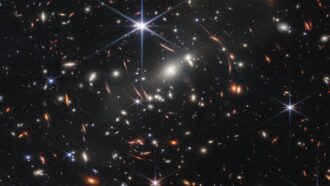

Did James Webb telescope images ‘break’ the universe?
Explainer: what is the solar cycle.

Scientists Say: Corona

Get ready for the 2024 total solar eclipse

Let’s learn about meteorites

Scientists Say: Solar Cycle

The weird sky glow called STEVE is really confusing scientists

This space physicist uses radios to study eclipses
Watch CBS News
Astronomers amazed to find supermassive black hole wandering aimlessly through space
By Sophie Lewis
March 16, 2021 / 11:30 AM EDT / CBS News
Astronomers have spotted a black hole on the move.
Supermassive black holes generally stay put as they suck in everything that comes their way, but scientists have long thought it was possible for them to wander through space. They've just never properly caught one in the act — until now.
Researchers and the Center for Astrophysics | Harvard & Smithsonian have identified the clearest example yet of a black hole in motion, publishing their findings in The Astrophysical Journal . About 230 million light years away, at the center of a galaxy named J0437+2456, the team found what they were looking for.
"We don't expect the majority of supermassive black holes to be moving; they're usually content to just sit around," lead author Dominic Pesce said in a news release . "They're just so heavy that it's tough to get them going. Consider how much more difficult it is to kick a bowling ball into motion than it is to kick a soccer ball — realizing that in this case, the 'bowling ball' is several million times the mass of our Sun. That's going to require a pretty mighty kick."
The team has been studying 10 distant galaxies and their supermassive black holes, specifically ones containing water, for the past five years. They were able to precisely measure a black hole's velocity based on the water orbiting the black hole, which produces a measurable laser-like beam of radio light, known as a "maser."
"We asked: Are the velocities of the black holes the same as the velocities of the galaxies they reside in?" Pesce explained. "We expect them to have the same velocity. If they don't, that implies the black hole has been disturbed."

Nine of the 10 black holes were resting — but one appeared to be in motion.
Follow-up observations with the Arecibo Observatory in Puerto Rico, before its collapse, and the Gemini Observatory in Hawaii and Chile confirmed the findings: The black hole, which has a mass that is 3 million times that of our sun, is moving at about 110,000 miles per hour inside its galaxy.
Scientists have two theories for the wandering black hole. One possibility? A collision.
"We may be observing the aftermath of two supermassive black holes merging," said co-author Jim Condon. "The result of such a merger can cause the newborn black hole to recoil, and we may be watching it in the act of recoiling or as it settles down again."
Scientists also think it's possible that the black hole is part of a pair.
"Despite every expectation that they really ought to be out there in some abundance, scientists have had a hard time identifying clear examples of binary supermassive black holes," Pesce says. "What we could be seeing in the galaxy J0437+2456 is one of the black holes in such a pair, with the other remaining hidden to our radio observations because of its lack of maser emission."
More observations are needed to understand the true cause of the peculiar movement.
- Supermassive Black Hole

Sophie Lewis is a social media manager and trending content writer for CBS News.
More from CBS News

Veteran taikonaut, 2 rookies launched to Chinese space station

Astronauts confident Boeing's Starliner is finally ready for crew flights

American arrested in Turks and Caicos after ammo found in luggage out on bail

Spacecraft spots "spiders" scattered across surface of Mars
- International edition
- Australia edition
- Europe edition

In a galaxy far, far away? The supermassive black hole wandering through space
US astrophysicists have located a travelling black hole that is sucking in matter as it goes. Should we be worried?
Name: Supermassive black holes.
Age: God knows. The Big Bang is estimated to have occurred about 14bn years ago.
What was happening before that? If I knew the answer to that question, I would be picking up the Nobel prize for physics, not bleedin’ talking to you.
Appearance: Black, of course, because their gravity is too dense to emit light, but the ones that have been observed have glowing accretion rings around them. They look like our sun during an eclipse.
We have pictures then? Incredibly, we do. The first one was captured in 2019 – a supermassive black hole in the galaxy Messier 87 , which is the small matter of 55m light years from Earth.
Remind me how black holes form. Common-or-garden black holes form when suns exhaust their thermonuclear energy and collapse in on themselves. There are millions of black holes in our galaxy, the Milky Way, alone.
And how many galaxies are there? A couple of trillion is the latest estimate. But can we get back to black holes, please. The origin of supermassive black holes, which have a mass millions of times greater than our sun, is disputed: some physicists believe they are formed by accreting matter – sucking it into its gravitational pull – while others believe they have existed since the origins of the universe. Almost every large galaxy is thought to have a supermassive black hole at its centre. Even the Milky Way has one – Sagittarius A, which is a mere 26,000 light years away from Earth.
Why don’t we have a photograph of our very own supermassive black hole ? Because there is too much dust and gas in the way. Fancy a trip up there with your smartphone?
Why are you telling us all this today ? Astrophysicists in the US have located a supermassive black hole that is wandering through space , sucking in matter as it goes. Are you all right? Why are you on the floor? Get the smelling salts, someone.
Sorry . I panicked there for a moment. Yes, a supermassive black hole travelling through space is a little disconcerting, but there’s no immediate cause for alarm. This one has a mass 3m times greater than that of our sun, but it’s in a galaxy known as J0437+2456, 230m light years from Earth , so we’ll probably be OK.
Will our sun become a black hole ? Our sun is too small to become even a common-or-garden black hole. It will expand and become what is known as a “red giant”, probably drawing the Earth and other planets in our solar system into itself, before shedding its outer layers and becoming a “white dwarf”. That, my friends, is our fate. Oh, you’ve fainted again!
Not to be confused with: Rishi Sunak’s budget strategy .
Do say: “Good to see Pass notes tackling the big issues in theoretical physics.”
Don’t say: “We’re all doomed!”
Comments (…)
Most viewed.
Most massive stellar black hole in our galaxy found
Astronomers have identified the most massive stellar black hole yet discovered in the Milky Way galaxy. This black hole was spotted in data from the European Space Agency's Gaia mission because it imposes an odd 'wobbling' motion on the companion star orbiting it. Data from the European Southern Observatory's Very Large Telescope (ESO's VLT) and other ground-based observatories were used to verify the mass of the black hole, putting it at an impressive 33 times that of the Sun.
Stellar black holes are formed from the collapse of massive stars and the ones previously identified in the Milky Way are on average about 10 times as massive as the Sun. Even the next most massive stellar black hole known in our galaxy, Cygnus X-1, only reaches 21 solar masses, making this new 33-solar-mass observation exceptional [1].
Remarkably, this black hole is also extremely close to us -- at a mere 2000 light-years away in the constellation Aquila, it is the second-closest known black hole to Earth. Dubbed Gaia BH3 or BH3 for short, it was found while the team were reviewing Gaia observations in preparation for an upcoming data release. "No one was expecting to find a high-mass black hole lurking nearby, undetected so far," says Gaia collaboration member Pasquale Panuzzo, an astronomer at the Observatoire de Paris, part of France's National Centre for Scientific Research (CNRS). "This is the kind of discovery you make once in your research life."
To confirm their discovery, the Gaia collaboration used data from ground-based observatories, including from the Ultraviolet and Visual Echelle Spectrograph (UVES) instrument on ESO's VLT, located in Chile's Atacama Desert [2]. These observations revealed key properties of the companion star, which, together with Gaia data, allowed astronomers to precisely measure the mass of BH3.
Astronomers have found similarly massive black holes outside our galaxy (using a different detection method), and have theorised that they may form from the collapse of stars with very few elements heavier than hydrogen and helium in their chemical composition. These so-called metal-poor stars are thought to lose less mass over their lifetimes and hence have more material left over to produce high-mass black holes after their death. But evidence directly linking metal-poor stars to high-mass black holes has been lacking until now.
Stars in pairs tend to have similar compositions, meaning that BH3's companion holds important clues about the star that collapsed to form this exceptional black hole. UVES data showed that the companion was a very metal-poor star, indicating that the star that collapsed to form BH3 was also metal-poor -- just as predicted.
The research study, led by Panuzzo, is published today in Astronomy & Astrophysics. "We took the exceptional step of publishing this paper based on preliminary data ahead of the forthcoming Gaia release because of the unique nature of the discovery," says co-author Elisabetta Caffau, also a Gaia collaboration member from the CNRS Observatoire de Paris. Making the data available early will let other astronomers start studying this black hole right now, without waiting for the full data release, planned for late 2025 at the earliest.
Further observations of this system could reveal more about its history and about the black hole itself. The GRAVITY instrument on ESO's VLT Interferometer, for example, could help astronomers find out whether this black hole is pulling in matter from its surroundings and better understand this exciting object.
[1] This is not the most massive black hole in our galaxy -- that title belongs to Sagittarius A*, the supermassive black hole at the Milky Way's centre, which has about four million times the mass of the Sun. But Gaia BH3 is the most massive black hole known in the Milky Way that formed from the collapse of a star.
[2] Aside from UVES on ESO's VLT, the study relied on data from: the HERMES spectrograph at the Mercator Telescope operated at La Palma (Spain) by Leuven University, Belgium, in collaboration with the Observatory of the University of Geneva, Switzerland; and the SOPHIE high-precision spectrograph at the Observatoire de Haute-Provence -- OSU Institut Pythéas.
- Black Holes
- Astrophysics
- Solar Flare
- Extrasolar Planets
- Space Telescopes
- Spitzer space telescope
- Holographic Universe
- Interstellar medium
Story Source:
Materials provided by ESO . Note: Content may be edited for style and length.
Related Multimedia :
- Artist’s impression of the system with the most massive stellar black hole in our galaxy
Journal Reference :
- P. Panuzzo, T. Mazeh, F. Arenou, B. Holl, E. Caffau, A. Jorissen, C. Babusiaux, P. Gavras, J. Sahlmann, U. Bastian, Ł. Wyrzykowski, L. Eyer, N. Leclerc, N. Bauchet, A. Bombrun, N. Mowlavi, G.M. Seabroke, D. Teyssier, E. Balbinot, A. Helmi, A.G.A. Brown, A. Vallenari, T. Prusti, J.H.J. de Bruijne, A. Barbier, M. Biermann, O.L. Creevey, C. Ducourant, D.W. Evans, R. Guerra, A. Hutton, C. Jordi, S.A. Klioner, U. Lammers, L. Lindegren, X. Luri, F. Mignard, C. Nicolas, S. Randich, P. Sartoretti, R. Smiljanic, P. Tanga, N.A. Walton, C. Aerts, C.A.L. Bailer-Jones, M. Cropper, R. Drimmel, F. Jansen, D. Katz, M.G. Lattanzi, C. Soubiran, F. Thévenin, F. van Leeuwen, R. Andrae, M. Audard, J. Bakker, R. Blomme, J. Castañeda, F. De Angeli, C. Fabricius, M. Fouesneau, Y. Frémat, L. Galluccio, A. Guerrier, U. Heiter, E. Masana, R. Messineo, K. Nienartowicz, F. Pailler, F. Riclet, W. Roux, R. Sordo, G. Gracia-Abril, J. Portell, M. Altmann, K. Benson, J. Berthier, P.W. Burgess, D. Busonero, G. Busso, C. Cacciari, H. Cánovas, J.M. Carrasco, B. Carry, A. Cellino, N. Cheek, G. Clementini, Y. Damerdji, M. Davidson, P. de Teodoro, L. Delchambre, A. Dell'Oro, E. Fraile Garcia, D. Garabato, P. García-Lario, R. Haigron, N.C. Hambly, D.L. Harrison, D. Hatzidimitriou, J. Hernández, D. Hestroffer, S.T. Hodgkin, S. Jamal, G. Jevardat de Fombelle, S. Jordan, A. Krone-Martins, A.C. Lanzafame, W. Löffler, A. Lorca, O. Marchal, P.M. Marrese, A. Moitinho, K. Muinonen, M. Nuñez Campos, I. Oreshina-Slezak, P. Osborne, E. Pancino, T. Pauwels, A. Recio-Blanco, M. Riello, L. Rimoldini, A.C. Robin, T. Roegiers, L.M. Sarro, M. Schultheis, M. Smith, A. Sozzetti, E. Utrilla, M. van Leeuwen, K. Weingrill, U. Abbas, P. Ábrahám, A. Abreu Aramburu, S. Ahmed, G. Altavilla, M.A. Álvarez, F. Anders, R.I. Anderson, E. Anglada Varela, T. Antoja, S. Baig, D. Baines, S.G. Baker, L. Balaguer-Núñez, Z. Balog, C. Barache, M. Barros, M.A. Barstow, S. Bartolomé, D. Bashi, J.-L. Bassilana, N. Baudeau, U. Becciani, L.R. Bedin, I. Bellas-Velidis, M. Bellazzini, W. Beordo, M. Bernet, C. Bertolotto, S. Bertone, L. Bianchi, A. Binnenfeld, S. Blanco-Cuaresma, J. Bland-Hawthorn, A. Blazere, T. Boch, D. Bossini, S. Bouquillon, A. Bragaglia, J. Braine, E. Bratsolis, E. Breedt, A. Bressan, N. Brouillet, E. Brugaletta, B. Bucciarelli, A.G. Butkevich, R. Buzzi, A. Camut, R. Cancelliere, T. Cantat-Gaudin, D. Capilla Guilarte, R. Carballo, T. Carlucci, M.I. Carnerero, J. Carretero, S. Carton, L. Casamiquela, A. Casey, M. Castellani, A. Castro-Ginard, L. Ceraj, V. Cesare, P. Charlot, C. Chaudet, L. Chemin, A. Chiavassa, N. Chornay, D. Chosson, W.J. Cooper, T. Cornez, S. Cowell, M. Crosta, C. Crowley, M. Cruz Reyes, C. Dafonte, M. Dal Ponte, M. David, P. de Laverny, F. De Luise, R. De March, J. De Ridder, A. de Torres, E.F. del Peloso, M. Delbo, A. Delgado, J.-B. Delisle, C. Demouchy, E. Denis, T.E. Dharmawardena, F. Di Giacomo, C. Diener, E. Distefano, C. Dolding, K. Dsilva, H. Enke, C. Fabre, M. Fabrizio, S. Faigler, M. Fatović, G. Fedorets, J. Fernández-Hernández, P. Fernique, F. Figueras, C. Fouron, F. Fragkoudi, M. Gai, M. Galinier, A. Garcia-Serrano, M. García-Torres, A. Garofalo, E. Gerlach, R. Geyer, P. Giacobbe, G. Gilmore, S. Girona, G. Giuffrida, A. Gomboc, A. Gomez, I. González-Santamaría, E. Gosset, M. Granvik, V. Gregori Barrera, R. Gutiérrez-Sánchez, M. Haywood, A. Helmer, S.L. Hidalgo, T. Hilger, D. Hobbs, C. Hottier, H.E. Huckle, Ó. Jiménez-Arranz, J. Juaristi Campillo, Z. Kaczmarek, P. Kervella, S. Khanna, M. Kontizas, G. Kordopatis, A.J. Korn, Á Kóspál, Z. Kostrzewa-Rutkowska, K. Kruszyńska, M. Kun, S. Lambert, A.F. Lanza, Y. Lebreton, T. Lebzelter, S. Leccia, G. Lecoutre, S. Liao, L. Liberato, E. Licata, E. Livanou, A. Lobel, J. López-Miralles, C. Loup, M. Madarász, L. Mahy, R.G. Mann, M. Manteiga, C.P. Marcellino, J.M. Marchant, M. Marconi, D. Marín Pina, S. Marinoni, D.J. Marshall, J. Martín Lozano, L. Martin Polo, J.M. Martín-Fleitas, G. Marton, D. Mascarenhas, A. Masip, A. Mastrobuono-Battisti, P.J. McMillan, J. Meichsner, J. Merc, S. Messina, N.R. Millar, A. Mints, D. Mohamed, D. Molina, R. Molinaro, o, P. Montegriffo, L. Monti, A. Mora, R. Morbidelli, D. Morris, R. Mudimadugula, T. Muraveva, I. Musella, Z. Nagy, N. Nardetto, C. Navarrete, S. Oh, C. Ordenovic, O. Orenstein, C. Pagani, I. Pagano, L. Palaversa, P.A. Palicio, L. Pallas-Quintela, M. Pawlak, A. Penttilä, P. Pesciullesi, M. Pinamonti, E. Plachy, L. Planquart, G. Plum, E. Poggio, A.M. Price-Whelan, L. Pulone, V. Rabin, M. Rainer, C.M. Raiteri, P. Ramos, M. Ramos-Lerate, M. Ratajczak, P. Re Fiorentin, S. Regibo, C. Reylé, V. Ripepi, A. Riva, H.-W. Rix, G. Rixon, G. Robert, N. Robichon, C. Robin, M. Romero-Gómez, N. Rowell, D. Ruz Mieres, K.A. Rybicki, G. Sadowski, A. Sagristà Sellés, N. Sanna, R. Santoveña, M. Sarasso, M.H. Sarmiento, C. Sarrate Riera, E. Sciacca, D. Ségransan, M. Semczuk, S. Shahaf, A. Siebert, E. Slezak, R.L. Smart, O.N. Snaith, E. Solano, F. Solitro, D. Souami, J. Souchay, E. Spitoni, F. Spoto, L.A. Squillante, I.A. Steele, H. Steidelmüller, J. Surdej, L. Szabados, F. Taris, M.B. Taylor, R. Teixeira, T. Tepper-Garcia, W. Thuillot, L. Tolomei, N. Tonello, F. Torra, G. Torralba Elipe, M. Trabucchi, E. Trentin, M. Tsantaki, C. Turon, A. Ulla, N. Unger, I. Valtchanov, O. Vanel, A. Vecchiato, D. Vicente, E. Villar, M. Weiler, H. Zhao, J. Zorec, S. Zucker, A. Župić, T. Zwitter. Discovery of a dormant 33 solar-mass black hole in pre-release Gaia astrometry . Astronomy & Astrophysics , 2024; DOI: 10.1051/0004-6361/202449763
Cite This Page :
Explore More
- Loneliness Runs Deep Among Parents
- Food in Sight? The Liver Is Ready!
- Acid Reflux Drugs and Risk of Migraine
- Do Cells Have a Hidden Communication System?
- Mice Given Mouse-Rat Brains Can Smell Again
- How Do Birds Flock? New Aerodynamics
- Cancer: Epigenetic Origin Without DNA Mutation
- Climate Change Driving Biodiversity Loss
- Why Can't Robots Outrun Animals?
- Evolution of Gliding in Marsupials
Trending Topics
Strange & offbeat.

Sleeping giant surprises Gaia scientists
Wading through the wealth of data from ESA’s Gaia mission , scientists have uncovered a ‘sleeping giant’. A large black hole, with a mass of nearly 33 times the mass of the Sun, was hiding in the constellation Aquila, less than 2000 light-years from Earth. This is the first time a black hole of stellar origin this big has been spotted within the Milky Way. So far, black holes of this type have only been observed in very distant galaxies. The discovery challenges our understanding of how massive stars develop and evolve.
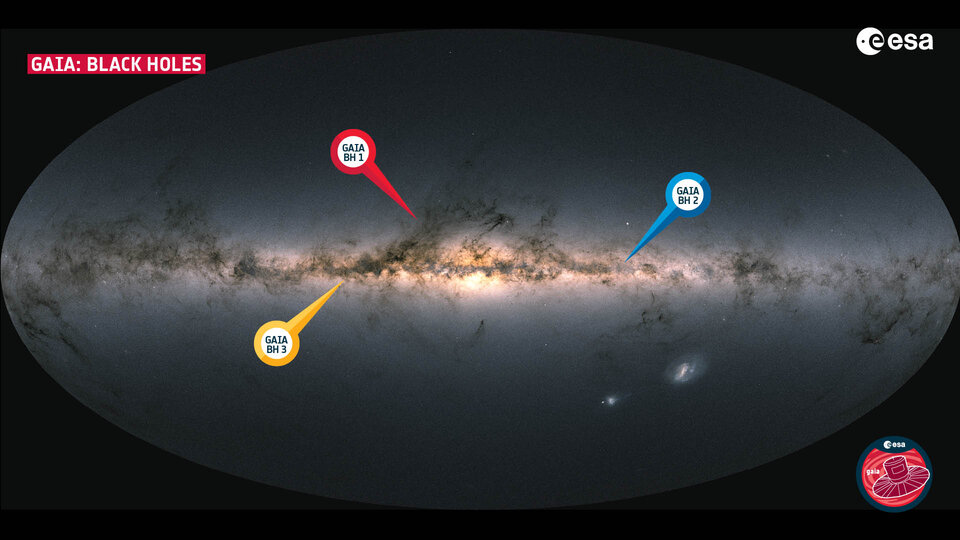
Matter in a black hole is so densely packed that nothing can escape its immense gravitational pull, not even light. The great majority of stellar-mass black holes that we know of are gobbling up matter from a nearby star companion. The captured material falls onto the collapsed object at high speed, becoming extremely hot and releasing X-rays. These systems belong to a family of celestial objects named X-ray binaries.
When a black hole does not have a companion close enough to steal matter from, it does not generate any light and is extremely difficult to spot. These black holes are called ‘dormant’.
To prepare for the release of the next Gaia catalogue, Data Release 4 (DR4), scientists are checking the motions of billions of stars and carrying out complex tests to see if anything is out of the ordinary. The motions of stars can be affected by companions: light ones, like exoplanets; heavier ones, like stars; or very heavy ones, like black holes. Dedicated teams are in place in the Gaia Collaboration to investigate any ‘odd’ cases.
One such team was deeply engaged in this work, when their attention fell on an old giant star in the constellation Aquila, at a distance of 1926 light-years from Earth. By analysing in detail the wobble in the star’s path, they found a big surprise. The star was locked in an orbital motion with a dormant black hole of exceptionally high mass, about 33 times that of the Sun.
This is the third dormant black hole found with Gaia and was aptly named ‘Gaia BH3’. Its discovery is very exciting because of the mass of the object. “This is the kind of discovery you make once in your research life,” exclaims Pasquale Panuzzo of CNRS, Observatoire de Paris, in France, who is the lead author of this finding. “So far, black holes this big have only ever been detected in distant galaxies by the LIGO–Virgo–KAGRA collaboration, thanks to observations of gravitational waves.”
The average mass of known black holes of stellar origin in our galaxy is around 10 times the mass of our Sun. Until now, the weight record was held by a black hole in an X-ray binary in the Cygnus constellation (Cyg X-1), whose mass is estimated to be around 20 times that of the Sun.
“It’s impressive to see the transformational impact Gaia is having on astronomy and astrophysics,” notes Prof. Carole Mundell, ESA Director of Science. “Its discoveries are reaching far beyond the original purpose of the mission, which is to create an extraordinarily precise multi-dimensional map of more than a billion stars throughout our Milky Way."
Unmatched accuracy
The exquisite quality of the Gaia data enabled scientists to pin down the mass of the black hole with unparalleled accuracy and provide the most direct evidence that black holes in this mass range exist.
Astronomers face the pressing question of explaining the origin of black holes as large as Gaia BH3. Our current understanding of how massive stars evolve and die does not immediately explain how these types of black holes came to be.
Most theories predict that, as they age, massive stars shed a sizable part of their material through powerful winds; ultimately, they are partly blown into space when they explode as supernovas. What remains of their core further contracts to become either a neutron star or a black hole, depending on its mass. Cores large enough to end up as black holes of 30 times the mass of our Sun are very difficult to explain.
Yet, a clue to this puzzle may lie very close to Gaia BH3.
An intriguing companion
The star orbiting Gaia BH3 at about 16 times the Sun–Earth distance is rather uncommon: an ancient giant star, that formed in the first two billion years after the Big Bang, at the time our galaxy started to assemble. It belongs to the family of the Galactic stellar halo and is moving in the opposite direction to the stars of the Galactic disc. Its trajectory indicates that this star was probably part of a small galaxy, or a globular cluster, engulfed by our own galaxy more than eight billion years ago.
The companion star has very few elements heavier than hydrogen and helium, indicating that the massive star that became Gaia BH3 could also have been very poor in heavy elements. This is remarkable. It supports, for the first time, the theory that the high-mass black holes observed by gravitational wave experiments were produced by the collapse of primeval massive stars poor in heavy elements. These early stars might have evolved differently from the massive stars we currently see in our galaxy.
The composition of the companion star can also shed light on the formation mechanism of this astonishing binary system. "What strikes me is that the chemical composition of the companion is similar to what we find in old metal-poor stars in the galaxy,” explains Elisabetta Caffau of CNRS, Observatoire de Paris, also a member of the Gaia collaboration.
“There is no evidence that this star was contaminated by the material flung out by the supernova explosion of the massive star that became BH3.” This could suggest that the black hole acquired its companion only after its birth, capturing it from another system.
Tasty appetiser
The discovery of the Gaia BH3 is only the beginning and much remains to be investigated about its baffling nature. Now that the scientists’ curiosity has been piqued, this black hole and its companion will undoubtedly be the subject of many in-depth studies to come.
The Gaia collaboration stumbled upon this ‘sleeping giant’ while checking the preliminary data in preparation for the fourth release of the Gaia catalogue. Because the finding is so exceptional they decided to announce it ahead of the official release.
The next release of Gaia data promises to be a goldmine for the study of binary systems and the discovery of more dormant black holes in our galaxy. “We have been working extremely hard to improve the way we process specific datasets compared to the previous data release (DR3), so we expect to uncover many more black holes in DR4,” concludes Berry Holl of the University of Geneva, in Switzerland, member of the Gaia collaboration.

Notes for editors
" Discovery of a dormant 33 solar-mass black hole in pre-release Gaia astrometry " by Gaia Collaboration, P. Panuzzo, et al. is published today the journal Astronomy & Astrophysics (A&A).
Gaia is a European mission, built and operated by ESA. It was approved in 2000 as a European Space Agency Cornerstone Mission within ESA’s Horizon 2000 Plus science programme, supported by all ESA Member States. Member States also have a key role in the science portion of the mission as part of the Data Processing and Analysis Consortium (DPAC) responsible to turn the raw data into scientific products for Gaia Data Releases, in collaboration with ESA. DPAC brings together more than 450 specialists from throughout the scientific community in Europe. Gaia was designed and built by Astrium (now Airbus Defence and Space), with a core team composed of Astrium France, Germany and UK. The industrial team included 50 companies from 15 European states, along with firms from the US. The spacecraft was launched by Arianespace on 19 December 2013.
A listing of the researchers involved and the role of ESA Member States is available for media here [PDF].
Further information about this discovery
Thank you for liking
You have already liked this page, you can only like it once!
Related Articles
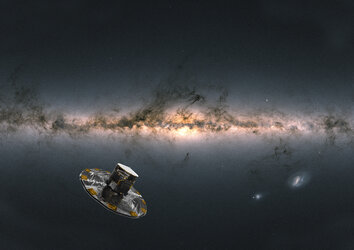
Gaia’s decade of discoveries: unravelling the intricacies o…
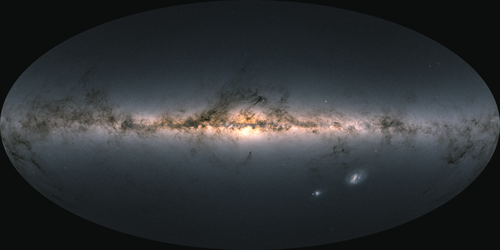
Gaia factsheet
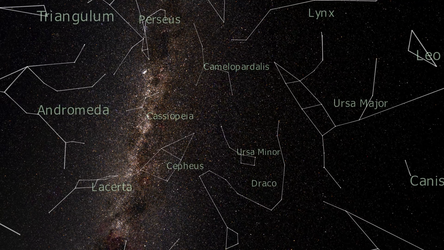
How does Gaia study the Milky Way?
European astronomers discover Milky Way's largest stellar-mass black hole: What to know
Astronomers say the findings, published tuesday in the journal astronomy & astrophysics, challenge our understanding of how massive stars develop and evolve..

Until recently, a large black hole formed from a collapsed star was able to avoid detection from the prying eyes of our powerful telescopes – despite lurking nearby Earth and being 33 times the mass of the sun.
But thanks to a little bit of serendipity, European astronomers were able to locate the stellar black hole just 2,000 light years from Earth. Scientists wading through data from the European Space Agency's Gaia mission stumbled upon the discovery of the "sleeping giant," which was fittingly dubbed Gaia-BH3.
Using data from the European Southern Observatory’s Very Large Telescope in Chile and other ground-based observatories, scientists were able to confirm something marvelous about BH3: The object is indeed the most massive stellar-mass black hole yet found in the Milky Way.
Astronomers say the findings, published Tuesday in the journal Astronomy & Astrophysics , challenge our understanding of how massive stars develop and evolve. Here's what to know about stellar black holes and why this discovery is considered so momentous.
Out of this world: From Stanley cups to Samsung phones, this duo launches almost anything into space
Scientists found BH3 while analyzing Gaia mission data
Astronomers divide black holes into three general categories based on mass: stellar-mass, supermassive , and intermediate-mass.
In the case of stellar-mass black holes, when a star with more than eight times the sun’s mass runs out of fuel, its core explodes as a supernova. What’s left behind depends on the star’s mass before the explosion, according to NASA.
Most black holes of this type have only been observed in very distant galaxies, yet this one was found within the Milky Way in the constellation Aquila, making it the second-closest known black hole to Earth, according to the ESA.
BH3 is also the largest black hole of stellar origin ever spotted within the Milky Way, astronomers said.
The discovery came as scientists were analyzing data as part of the the agency's Gaia mission , an astronomical observatory mission with the purpose of creating the largest, most precise three-dimensional map of the Milky Way.
While checking the preliminary data in preparation for next year's release of the Gaia catalogue, researchers stumbled upon an old giant star exhibiting an odd "wobbling" motion. Further analysis of the data led them to a big surprise: The star was orbiting a dormant black hole of "exceptionally high mass," according to the ESA.
BH3 is largest stellar black hole found in Milky Way
As its name suggests, BH3 is not the first of its kind to be discovered.
The European Space Agency announced the discovery about a year ago of Gaia BH1 and Gaia BH2. While these stellar black holes are much closer to Earth than BH3 – just 1,560 light-years away – they aren't nearly as big.
Even what was until now the most massive stellar black hole known in our galaxy, Cygnus X-1, is only about 20 times the mass of the sun, "making this new 33-solar-mass observation exceptional," the European Southern Observatory said in a news release .
“This is the kind of discovery you make once in your research life,” the study's lead author Pasquale Panuzzo, an astronomer and member of the Gaia collaboration at the Observatoire de Paris, said in a statement. “So far, black holes this big have only ever been detected in distant galaxies."
Astronomers hope further study aids understanding of object's 'baffling nature'
Astronomers theorize that stellar black holes form from the collapse of stars with very few elements heavier than hydrogen and helium in their chemical composition.
These metal-poor stars are thought to lose less mass over their lifetimes and hence have more material left over to produce high-mass black holes after their death, according to the ESO.
Stellar-mass black holes can continue to gain mass through collisions with stars and other black holes.
Of course, BH3 pales in comparison to the behemoth that is Sagittarius A* , which has a mass 4.2 million times that of the sun. Unlike stellar-mass black holes, supermassive black holes like Sagittarius A* can grow by eating smaller objects such as gas, stars, planets and even other black holes .
But astronomers still struggle to understand and explain exactly how these types of black holes came to be, especially one 30 times the mass of the sun.
While Gaia wasn't expected to release further results until 2025, researchers said this finding is so exceptional that they felt compelled to reveal it in advance so other astronomers can perform observations of their own.
"The discovery of the Gaia BH3 is only the beginning," the ESA said in a statement. "Much remains to be investigated about its baffling nature."
Eric Lagatta covers breaking and trending news for USA TODAY. Reach him at [email protected]
Explosive black hole flare from the center of our galaxy reconstructed from 'a single flickering pixel' using AI and Einstein's equations
An explosive flare from the Milky Way's central black hole has been translated from 'a single flickering pixel' into a detailed 3D model using AI and Einstein's general relativity equations.
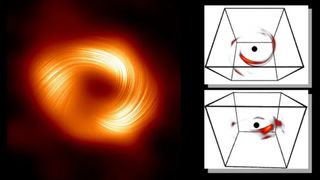
Scientists have used artificial intelligence to construct a three-dimensional model of an energetic outburst, or flare, that occurred around the Milky Way 's central black hole, Sagittarius A* (Sgr A*). This 3D model could help scientists develop a clearer picture of the tumultuous environment that forms around supermassive black holes in general.
The material swirling around Sgr A* exists in a flattened structure called an "accretion disk" that can periodically flare. These flares occur across a range of light wavelengths, all the way from high-energy X-rays to low-energy infrared light and radio waves.
The supercomputer simulations suggest a flare seen by the Atacama Large Millimeter/Submillimeter Array (ALMA) on April 11, 2017 originated from two bright spots of dense material in Sgr A*'s accretion disk, both of which were facing Earth. Those bright spots swirl around the supermassive black hole, which has a mass around 4.2 million times that of the sun, while separated by around half the distance between the Earth and the sun . That's around 47 million miles (75 million kilometers).
Reconstructing these flares in 3D from observational data is no mean feat. To tackle this, the team, led by California Institute of Technology scientist Aviad Levis, proposed a new imaging technique called "orbital polarimetric tomography." The method is not unlike medical computed tomography, or CT, scans carried out in hospitals around the globe.
"The compact region around the galactic center is an extreme place where hot, magnetized gas orbits a supermassive black hole at relativistic velocities [speeds approaching that of light]. This unique environment powers highly energetic eruptions known as flares, which leave observational signatures at X-ray, infrared and radio wavelengths," Levis told Space.com. "Recently, theorists proposed several mechanisms for the emergence of such flares, one of which is through extremely bright, compact regions that suddenly form within the accretion disk."
The key result of this work, he added, is the recovery of what the 3D structure of radio brightness around Sgr A* might look like directly after a flare detection.
Related: Supermassive black hole at the heart of the Milky Way is approaching the cosmic speed limit, dragging space-time along with it
Sign up for the Live Science daily newsletter now
Get the world’s most fascinating discoveries delivered straight to your inbox.
Building a black hole from a single pixel
"Sgr A* lies in the heart of our own Milky Way galaxy, making it the nearest supermassive black hole and a prime candidate to study such flares," Levis said. "To do that effectively, you still need an element of luck when ALMA observations coincide with a flare."
He explained that, on April 11, 2017, ALMA was observing Sgr A* directly after a violent eruption captured in X-rays. The radio data acquired by ALMA had a periodic signal that was consistent with what would be expected for an orbit around Sgr A*.
"This prompted our development of a computational approach that could extract the 3D structure from the time series data that ALMA observes," Levis added. "In contrast to the Event Horizon Telescope (EHT) 2D image of Sgr A*, we were interested in recovering the 3D volume, and to do that, we relied on physical modeling of how light travels along curved trajectories within the strong gravitational field of a black hole."
To achieve their results, the scientists looked at physics derived from Albert Einstein's 1915 theory of gravity, general relativity, then applied those concepts around supermassive black holes to a neural network. This network was then used create the Sgr A* model.
"This work is a unique collaboration between astronomers and computer scientists advancing cutting-edge computational tools from both the fields of AI and gravitational physics, each contributing an important part of the whole in this first attempt at revealing the 3D radio emission structure around Sgr A*," Levis said. "The result is not a photograph in the regular sense; rather, it is a computational 3D image extracted from time-series observations by constraining a neural network with the expected physics of how gas orbits the black hole and how synchrotron radiation is emitted in the process."
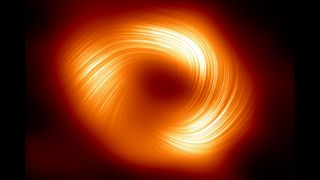
He explained that the team computationally placed 3D "emissions" in orbit around Sgr A*, starting with an arbitrary structure. Through ray tracing, which refers to graphical simulations of the physical behavior of light, Levis and colleagues were able to model how ALMA would see the structure around Sgr A* in future times. Those models started 10 minutes after the flare, then 20 minutes later, 30 minutes later — and so on.
"The technology of neural radiance fields and general relativistic ray tracing gives us a way to start changing the 3D structure until the model matches the observations," Levis added.
The team found that this delivered conclusions about the environment around Sgr A* that are indeed predicted by theory, showing brightness is concentrated at several small regions within the accretion disk. Still, aspects of this work were surprising to Levis and the rest of the team.
"The biggest surprise was that we were able to recover the 3D structure from light curve observations ... essentially a video of a single flickering pixel," the researcher said. "Think about it: if I were to tell you that you could recover a video from just one single pixel, you would say that sounds practically impossible. The key is that we are not recovering an arbitrary video.
"We are recovering the 3D structure of emission around a black hole, and we can leverage the expected gravitational and emission physics to constrain our reconstruction."
Levis added that the fact ALMA measures not just the intensity of light but also its polarization gave the team a highly informative signal with clues about the 3D structure of flares around Sgr A*.
Going forward, Levis said he and the team intend to run the simulation while changing the parameters of the physics used to constrain the AI.
— Most massive stellar black hole in the Milky Way discovered 'extremely close' to Earth
— 'Green Monster' supernova is the youngest in the Milky Way, James Webb telescope reveals
— Black holes may be swallowing invisible matter that slows the movement of stars
"These results are an exciting first step, which relies on the belief that Sgr A* is a black hole whose environment obeys the prescribed gravitational and emission models; the accuracy of our result hinges on the validity of these assumptions," Levis concluded. "In the future, we would like to loosen these constraints to allow deviations from expected physics.
"Our approach, which harnesses the synergy between physics and AI, opens up the door to new and exciting questions whose answers will continue to advance our understanding of black holes and the universe." The team's research was published on Monday (April 22) in the journal Nature Astronomy.
Originally published on Space.com

Robert Lea is a science journalist in the U.K. who specializes in science, space, physics, astronomy, astrophysics, cosmology, quantum mechanics and technology. Rob's articles have been published in Physics World, New Scientist, Astronomy Magazine, All About Space and ZME Science. He also writes about science communication for Elsevier and the European Journal of Physics. Rob holds a bachelor of science degree in physics and astronomy from the U.K.’s Open University
Most massive stellar black hole in the Milky Way discovered 'extremely close' to Earth
Some stars may be 'infected' with black holes that destroy them from within, new study hints
Blood test powered by AI could catch osteoarthritis 8 years earlier than X-ray, early data show
Most Popular
- 2 Claude 3 Opus has stunned AI researchers with its intellect and 'self-awareness' — does this mean it can think for itself?
- 3 Giant, 82-foot lizard fish discovered on UK beach could be largest marine reptile ever found
- 4 Global 'time signals' subtly shifted as the total solar eclipse reshaped Earth's upper atmosphere, new data shows
- 5 Scientists discover once-in-a-billion-year event — 2 lifeforms merging to create a new cell part
- 2 China green-lights mass production of autonomous flying taxis — with commercial flights set for 2025
- 3 George Washington's stash of centuries-old cherries found hidden under Mount Vernon floor
- 4 5 catastrophic megathrust earthquakes led to the demise of the pre-Aztec city of Teotihuacan, new study suggests
- 5 Scientists find one of the oldest stars in the universe in a galaxy right next to ours

- Latest news
- UCL in the media
- Services for media
- Student news
- Tell us your story

Large dormant black hole spotted in our galaxy
16 April 2024
The European Space Agency’s Gaia mission involving UCL researchers has discovered the most massive black hole in our galaxy to date that formed from an exploding star.
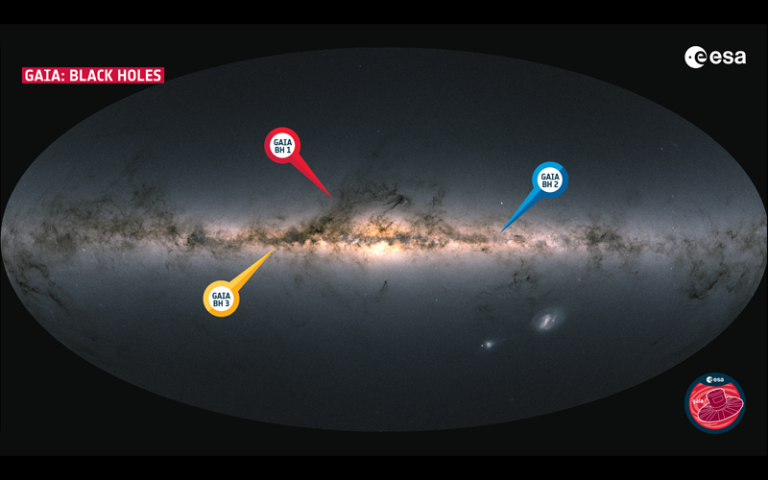
The black hole, known as Gaia BH3, is 33 times the mass of our Sun and located relatively close to Earth at 2,000 light years away. (The Milky Way is 100,000 light years across.)
The only black hole known to be more massive in our galaxy is the supermassive black hole at its centre which could not have been born from the collapse of a single exploding star and whose formation is tied to the formation of the Milky Way itself.
Gaia BH3 was not seen directly but inferred from the movements of what appeared to be a lone star now understood to be the black hole’s companion, i.e., gravitationally bound to the black hole and orbiting around a common point.
Most known black holes are active – that is, they gobble matter from a nearby star companion. Gaia BH3 is a dormant black hole as it does not have a companion close enough to steal matter from and does not generate any light. It is therefore much harder to spot.
Currently, there are about 50 confirmed or suspected black holes in our galaxy, but theory predicts there is a hidden population of thousands or millions, due to the number of stars that have likely already died over the galaxy’s lifetime.
Dr George Seabroke (Mullard Space Science Laboratory at UCL), a member of Gaia’s Black Hole Task Force, the team that made the discovery, said: “Finding Gaia BH3 is like the moment in the film The Matrix where Neo starts to ‘see’ the matrix. In our case, ‘the matrix’ is our galaxy’s population of dormant stellar black holes, which were hidden from us before Gaia detected them.
“Gaia BH3 is an important clue to this population because it is the most massive stellar black hole found in our galaxy. Gaia’s next data release is expected to contain many more, which should help us to ‘see’ more of ‘the matrix’ and to understand how dormant stellar black holes form.”
Lead author Dr Pasquale Panuzzo of CNRS, Observatoire de Paris, in France, said: “It's a real unicorn. This is the kind of discovery you make once in your research life. So far, black holes this big have only ever been detected in distant galaxies, by the LIGO–Virgo–KAGRA collaboration thanks to observations of gravitational waves.”
Professor Tsevi Mazeh of Tel Aviv University in Israel, who is a member of the Gaia collaboration, said: “Gaia BH3 is the very first black hole for which we could measure the mass so accurately,” remarks “At 30 times that of our Sun, the object’s mass is typical of the estimates we have for the masses of the very distant black holes observed by gravitational wave experiments. Gaia’s measurements provide the first undisputable proof that black holes this heavy do exist.”
The discovery also provides a clue to the puzzle of how black holes this massive form. Our current understanding of how massive stars evolve and die does not immediately explain how these types of black holes came to be.
The star orbiting Gaia BH3 has very few elements heavier than hydrogen and helium, indicating that the massive star that became Gaia BH3 could also have been very poor in heavy elements.
YouTube Widget Placeholder https://www.youtube.com/watch?v=zxT_G42JdjU
The star orbiting Gaia BH3 at about 16 times the Sun–Earth distance is rather uncommon: an ancient giant star, that formed in the first two billion years after the Big Bang, at the time our galaxy started to assemble. It belongs to the family of the Galactic stellar halo and is moving in the opposite direction to the stars of the Galactic disc. Its trajectory indicates that this star was probably part of a small galaxy, or a globular cluster, engulfed by our own galaxy more than eight billion years ago.
At the widest point of its orbit, the star is as far away from Gaia BH3 as Neptune is from the Sun. At its closest, it is about the distance of Jupiter from the Sun.
UCL Mullard Space Science Laboratory has contributed significantly to Gaia over more than 20 years by developing Gaia spectrometer concepts, testing and calibrating each of the 106 electronic detectors used to capture all of Gaia’s data, and by taking a major role in the spectroscopic data processing.
The UK team involved in the Gaia mission is supported by the UK Space Agency and the Science and Technology Facilities Council.
The findings will be published in a new paper in the journal Astronomy & Astrophysics.
- The paper in the journal Astronomy & Astrophysics
- Dr George Seabroke’s academic profile
- Mullard Space Science Laboratory at UCL
- UCL Mathematical & Physical Sciences
- ESA Gaia space mission
- On this sky map, Gaia’s three black holes are shown at their respective locations on the sky. Gaia BH1 was found in 2022 following Gaia’s Data Release 3, a catalogue based on 34 months of Gaia data. It is the closest black hole to Earth at ~1560 light years away. Gaia BH2 was found in 2023, also using Gaia’s data release 3. At the time of its discovery, it was the second closest black hole to Earth at ~3800 light years away. Gaia BH3 was found during the validation of Gaia’s preliminary data while preparing for Gaia Data Release 4, a catalogue that will be based on 66 months of Gaia data. Gaia BH3 is located at ~1900 light years away, which makes it the second closest black hole known today. Credits: ESA/Gaia/DPAC. License: CC BY-SA 3.0 IGO
Media contact
Mark greaves.
T: +44 (0)7990 675947
E: m.greaves [at] ucl.ac.uk

IMAGES
COMMENTS
The newly detected wandering black hole lies about 5,000 light-years away, in the Carina-Sagittarius spiral arm of our galaxy. However, its discovery allows astronomers to estimate that the nearest isolated stellar-mass black hole to Earth might be as close as 80 light-years away. The nearest star to our solar system, Proxima Centauri, is a ...
The stellar-mass black hole is located around 5,000 light-years from Earth in the Carina-Sagittarius spiral arm of the Milky Way. Usually, such objects have companion stars, yet this one is alone ...
The black hole passed in front of a background star located 19,000 light-years away from Earth toward the center of the galaxy, amplifying its starlight for 270 days.
The stellar-mass black hole is likely one of 100 million solitary black holes in the Milky Way, scientists said. A rogue black hole wandering the space lanes of our Milky Way galaxy alone could be ...
The first detection of what appears to be a rogue black hole drifting through the Milky Way, revealed earlier this year, just got important validation.. A second team of scientists, conducting a separate, independent analysis, has reached almost the same finding, adding weight to the idea that we've potentially identified a rogue black hole wandering the galaxy.
Yes, there are 100 million rogue black holes wandering our galaxy. The Milky Way is teeming with black holes. Black holes aren't evil. But they are fantastically weird, gravitationally powerful ...
The black hole distorts the space around it, which warps images of background stars lined up almost directly behind it. This gravitational "lensing" effect offers the only telltale evidence for the existence of lone black holes wandering our galaxy, which may be a population of 100 million.
There's a Black Hole in Our Galaxy With 7 Times More Mass Than the Sun, Astronomers Say. The wandering, lone black hole sits an estimated 5,000 light years away from us. This is the first direct ...
Astronomers Report The First-Ever Wandering Black Hole in Our Galaxy. The microlensing event MOA-11-191/OGLE-11-0462 as observed by Hubble. (Sahu et al., arXiv, 2022) Like an ancient cardigan, the Milky Way should be absolutely riddled with black holes. According to our best estimates, there should be as many as 10 million to 1 billion stellar ...
The newly detected wandering black hole lies about 5,000 light-years away, in the Carina-Sagittarius spiral arm of our galaxy. However, its discovery allows astronomers to estimate that the ...
Less than 2,000 light-years away from Earth, scientists have discovered a "sleeping giant"—the Milky Way's largest stellar black hole, with a mass 33 times greater than that of our sun.
Now, University of California at Berkeley scientists may have identified a free-floating black hole roaming the galaxy about 2,200 to 6,200 light-years from earth. The international team, led by ...
Using Hubble telescope data, two teams of astronomers think they have detected one such lone black hole located around 5,000 light-years away in the Carina-Sagittarius spiral arm of our galaxy ...
Three stellar-mass black holes in our galaxy: (left) Gaia BH1, (middle) Cygnus X-1, and (right) Gaia BH3, whose masses are 10, 21, and 33 times that of the sun, respectively. Gaia BH3 is the most ...
NASA announced this week that the Hubble Space Telescope detected what might be a wandering 'black hole' nearly 5,000 light-years away in the Milky Way Galaxy. The discovery led NASA to believe ...
While nine of the supermassive black holes were stationary, one appeared to be on the move. It's 230 million light-years away from Earth and can be found at the center of a galaxy known as J0437 ...
Hubble observations have revealed a stellar-mass compact object — a black hole or possibly a neutron star — wandering our galaxy. An illustration of a close-up look at a black hole drifting through our Milky Way galaxy. FECYT / IAC. Two international teams of astronomers may have just used the Hubble Space Telescope to make the first ...
Black hole pictured for first time — in spectacular detail. The observatory locations ranged from Spain to the South Pole and from Chile to Hawaii. They collected nearly 4 petabytes (4,000 ...
This Hubble Space Telescope image is centered on the object known as MOA-11-191/OGLE-11-0462. Astronomers say this object is the 1st-known wandering black hole found in our home galaxy, the Milky Way.
July 4, 2022 at 6:30 am. A solitary and massive celestial object is wandering our galaxy a few thousand light-years from Earth. It's not too big, but its mass is greater than our sun's. Astronomers suspect it might be the first loner black hole in the Milky Way found with a mass similar to our sun's. Or it could prove to be one of the ...
The black hole traps light due to its intense gravitational field, hence it cannot be seen directly. The black hole distorts the space around it, which warps images of stars lined up almost directly behind it. This offers telltale evidence for the existence of lone black holes wandering our galaxy. The light from a background star is deflected ...
A rogue black hole (also termed a free-floating, interstellar, nomad, orphan, unbound or wandering black hole) is an intergalactic object (i.e., an object without a host galactic group). [2] They are caused by collisions between two galaxies or when the merging of two black holes is disrupted. It has been estimated that there could be 12 rogue ...
The black hole, named Gaia BH3, is 33 times more massive than our sun. Cygnus X-1, the next-biggest stellar black hole known in our galaxy, weighs only 21 solar masses.
Galaxy J0437+2456 is thought to be home to a supermassive, moving black hole. Sloan Digital Sky Survey Nine of the 10 black holes were resting — but one appeared to be in motion.
The first one was captured in 2019 - a supermassive black hole in the galaxy Messier 87, which is the small matter of 55m light years from Earth. Remind me how black holes form.
Even the next most massive stellar black hole known in our galaxy, Cygnus X-1, only reaches 21 solar masses, making this new 33-solar-mass observation exceptional [1].
Wading through the wealth of data from ESA's Gaia mission, scientists have uncovered a 'sleeping giant'. A large black hole, with a mass of nearly 33 times the mass of the Sun, was hiding in the constellation Aquila, less than 2000 light-years from Earth. This is the first time a black hole of stellar origin this big has been spotted within the Milky Way. So far, black holes of this type ...
Even what was until now the most massive stellar black hole known in our galaxy, Cygnus X-1, is only about 20 times the mass of the sun, "making this new 33-solar-mass observation exceptional ...
Building a black hole from a single pixel "Sgr A* lies in the heart of our own Milky Way galaxy, making it the nearest supermassive black hole and a prime candidate to study such flares," Levis ...
The European Space Agency's Gaia mission involving UCL researchers has discovered the most massive black hole in our galaxy to date that formed from an exploding star. The black hole, known as Gaia BH3, is 33 times the mass of our Sun and located relatively close to Earth at 2,000 light years away. (The Milky Way is 100,000 light years across.)